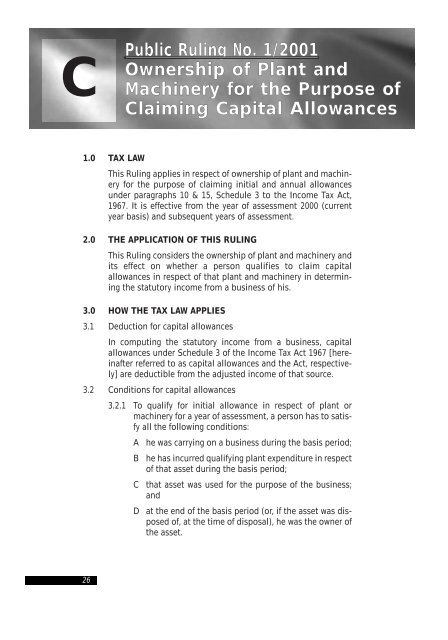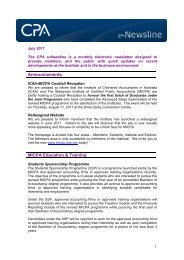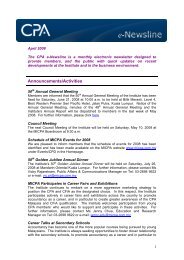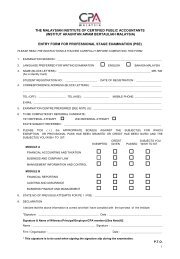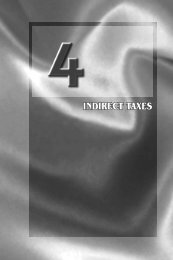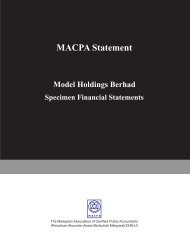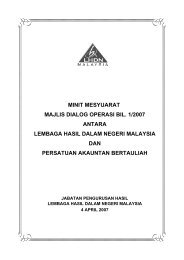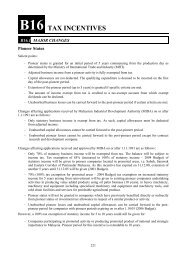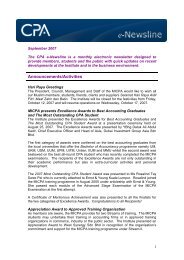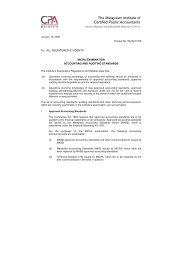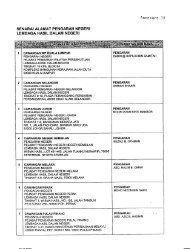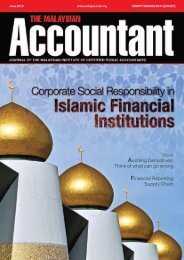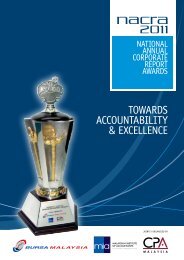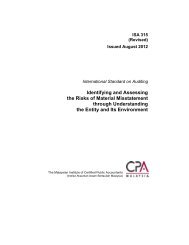Public Ruling No. 1/2001 Ownership of Plant and Machinery for the ...
Public Ruling No. 1/2001 Ownership of Plant and Machinery for the ...
Public Ruling No. 1/2001 Ownership of Plant and Machinery for the ...
Create successful ePaper yourself
Turn your PDF publications into a flip-book with our unique Google optimized e-Paper software.
<strong>Public</strong> <strong>Ruling</strong> <strong>No</strong>. 1/<strong>2001</strong><strong>Ownership</strong> <strong>of</strong> <strong>Plant</strong> <strong>and</strong><strong>Machinery</strong> <strong>for</strong> <strong>the</strong> Purpose <strong>of</strong>Claiming Capital AllowancesCCPA Tax & Investment Review 20031.0 TAX LAWThis <strong>Ruling</strong> applies in respect <strong>of</strong> ownership <strong>of</strong> plant <strong>and</strong> machinery<strong>for</strong> <strong>the</strong> purpose <strong>of</strong> claiming initial <strong>and</strong> annual allowancesunder paragraphs 10 & 15, Schedule 3 to <strong>the</strong> Income Tax Act,1967. It is effective from <strong>the</strong> year <strong>of</strong> assessment 2000 (currentyear basis) <strong>and</strong> subsequent years <strong>of</strong> assessment.2.0 THE APPLICATION OF THIS RULINGThis <strong>Ruling</strong> considers <strong>the</strong> ownership <strong>of</strong> plant <strong>and</strong> machinery <strong>and</strong>its effect on whe<strong>the</strong>r a person qualifies to claim capitalallowances in respect <strong>of</strong> that plant <strong>and</strong> machinery in determining<strong>the</strong> statutory income from a business <strong>of</strong> his.3.0 HOW THE TAX LAW APPLIES3.1 Deduction <strong>for</strong> capital allowancesIn computing <strong>the</strong> statutory income from a business, capitalallowances under Schedule 3 <strong>of</strong> <strong>the</strong> Income Tax Act 1967 [hereinafterreferred to as capital allowances <strong>and</strong> <strong>the</strong> Act, respectively]are deductible from <strong>the</strong> adjusted income <strong>of</strong> that source.3.2 Conditions <strong>for</strong> capital allowances3.2.1 To qualify <strong>for</strong> initial allowance in respect <strong>of</strong> plant ormachinery <strong>for</strong> a year <strong>of</strong> assessment, a person has to satisfyall <strong>the</strong> following conditions:A he was carrying on a business during <strong>the</strong> basis period;B he has incurred qualifying plant expenditure in respect<strong>of</strong> that asset during <strong>the</strong> basis period;C that asset was used <strong>for</strong> <strong>the</strong> purpose <strong>of</strong> <strong>the</strong> business;<strong>and</strong>D at <strong>the</strong> end <strong>of</strong> <strong>the</strong> basis period (or, if <strong>the</strong> asset was disposed<strong>of</strong>, at <strong>the</strong> time <strong>of</strong> disposal), he was <strong>the</strong> owner <strong>of</strong><strong>the</strong> asset.26
1• IRB (Inl<strong>and</strong> Revenue Board) Guidelines <strong>and</strong> <strong>Ruling</strong>s3.2.2 To qualify <strong>for</strong> annual allowance in respect <strong>of</strong> plant ormachinery <strong>for</strong> a year <strong>of</strong> assessment, a person has to satisfyall <strong>the</strong> following conditions:A. he was carrying on a business during <strong>the</strong> basis period;B. he had incurred qualifying plant expenditure inrespect <strong>of</strong> that asset;C. that asset was used <strong>for</strong> <strong>the</strong> purpose <strong>of</strong> <strong>the</strong> business;<strong>and</strong>D. at <strong>the</strong> end <strong>of</strong> <strong>the</strong> basis period, he was <strong>the</strong> owner <strong>of</strong> <strong>the</strong>asset <strong>and</strong> <strong>the</strong> asset was in use.3.3 <strong>Ownership</strong> <strong>of</strong> <strong>the</strong> asset3.3.1 “<strong>Ownership</strong>” <strong>of</strong> an asset refers to ei<strong>the</strong>r legal or beneficialownership.3.3.2 While it is normal <strong>for</strong> an asset to be owned <strong>and</strong> used by<strong>the</strong> same person in a business <strong>of</strong> his, it is also possiblethat:A. <strong>the</strong> asset is registered in <strong>the</strong> name <strong>of</strong> one person (<strong>the</strong>legal owner) [see paragraph 4.4 below] although <strong>the</strong>qualifying plant expenditure has been incurred byano<strong>the</strong>r person (<strong>the</strong> beneficial owner) [see paragraph4.3 below]; orB. <strong>the</strong> asset is registered in <strong>the</strong> name <strong>of</strong> one person (<strong>the</strong>legal owner) although <strong>the</strong> qualifying plant expenditurehas been incurred jointly by <strong>the</strong> legal owner <strong>and</strong>ano<strong>the</strong>r person; <strong>and</strong>C <strong>the</strong> asset is used <strong>for</strong> <strong>the</strong> purpose <strong>of</strong> <strong>the</strong> business <strong>of</strong> <strong>the</strong>legal owner or <strong>the</strong> business <strong>of</strong> <strong>the</strong> beneficial owner.3.4 Asset owned by <strong>and</strong> used <strong>for</strong> <strong>the</strong> purpose <strong>of</strong> <strong>the</strong> business <strong>of</strong> <strong>the</strong>same personA person who is both <strong>the</strong> beneficial <strong>and</strong> legal owner <strong>of</strong> an asset<strong>and</strong> uses that asset <strong>for</strong> <strong>the</strong> purpose <strong>of</strong> his business is entitled toclaim <strong>the</strong> capital allowances in respect <strong>of</strong> that asset.Example:Encik Salleh purchases a van on 21.06.2000 <strong>and</strong> registers itin his own name. He uses <strong>the</strong> van in his grocery business, <strong>for</strong>which accounts are prepared to 31 December every year. Asat 31.12.2000, <strong>the</strong> van is still in use.27
CPA Tax & Investment Review 2003In computing <strong>the</strong> statutory income from his grocery business <strong>for</strong> year <strong>of</strong>assessment 2000, Encik Salleh qualifies <strong>for</strong> capital allowances on <strong>the</strong> vanas he has fulfilled <strong>the</strong> prescribed conditions [see paragraph 3.2 above]:A. he was carrying on a business during <strong>the</strong> basis period;B. he has incurred qualifying plant expenditure <strong>for</strong> <strong>the</strong>purpose <strong>of</strong> his business;C. <strong>the</strong> asset was used <strong>for</strong> <strong>the</strong> purpose <strong>of</strong> his business during<strong>the</strong> basis period; <strong>and</strong>D at <strong>the</strong> end <strong>of</strong> <strong>the</strong> basis period, he was <strong>the</strong> owner <strong>of</strong> <strong>the</strong>asset <strong>and</strong> <strong>the</strong> asset was in use <strong>for</strong> <strong>the</strong> purpose <strong>of</strong> hisbusiness.3.5 Asset used <strong>for</strong> <strong>the</strong> purpose <strong>of</strong> <strong>the</strong> business <strong>of</strong> a person but registeredin <strong>the</strong> name <strong>of</strong> ano<strong>the</strong>r person3.5.1 Asset used <strong>for</strong> <strong>the</strong> purpose <strong>of</strong> <strong>the</strong> business <strong>of</strong> <strong>the</strong> beneficialowner but registered in <strong>the</strong> name <strong>of</strong> ano<strong>the</strong>r personWhere a person has:A. incurred <strong>the</strong> qualifying plant expenditure on asset;<strong>and</strong>B. that asset is used <strong>for</strong> <strong>the</strong> purpose <strong>of</strong> a business <strong>of</strong> hisduring <strong>the</strong> basis period; <strong>and</strong>C. <strong>the</strong> asset was still in use at <strong>the</strong> end <strong>of</strong> <strong>the</strong> basis period;that person (<strong>the</strong> beneficial owner) is entitled to claimboth <strong>the</strong> initial <strong>and</strong> annual allowances in respect <strong>of</strong>that asset, even though he is not <strong>the</strong> registered owner<strong>of</strong> <strong>the</strong> asset.Example:Encik Azmi purchases a lorry in basis year <strong>2001</strong> <strong>and</strong> registersit in <strong>the</strong> name <strong>of</strong> Encik Musa.The lorry is used by Encik Azmiin carrying on his transportation business. In computing <strong>the</strong>statutory income from <strong>the</strong> business <strong>of</strong> Encik Azmi <strong>for</strong> year <strong>of</strong>assessment <strong>2001</strong>, initial <strong>and</strong> annual allowances may beclaimed by him as he has fulfilled <strong>the</strong> prescribed conditions.EncikMusa is not entitled to claim any <strong>of</strong> <strong>the</strong>allowances as he has not incurred <strong>the</strong> qualifying plant expenditure.28
1• IRB (Inl<strong>and</strong> Revenue Board) Guidelines <strong>and</strong> <strong>Ruling</strong>s3.5.2 Asset registered in <strong>the</strong> name <strong>of</strong> a person <strong>and</strong> used <strong>for</strong> <strong>the</strong>purpose <strong>of</strong> <strong>the</strong> business <strong>of</strong> more than one beneficialownerWhere:A. more than one person has incurred qualifying plantexpenditure on an asset;B. that asset is used <strong>for</strong> <strong>the</strong> purpose <strong>of</strong> a business <strong>of</strong> each<strong>of</strong> <strong>the</strong>m during <strong>the</strong> basis period;C. <strong>the</strong> asset was still in use at <strong>the</strong> end <strong>of</strong> <strong>the</strong> basis period;<strong>and</strong>D. <strong>the</strong> asset is registered in <strong>the</strong> name <strong>of</strong> only one <strong>of</strong> <strong>the</strong>beneficial owners or in <strong>the</strong> name <strong>of</strong> some o<strong>the</strong>r person;each <strong>of</strong> <strong>the</strong> beneficial owners <strong>of</strong> <strong>the</strong> asset is entitled toclaim <strong>the</strong> capital allowances in respect <strong>of</strong> that asset in <strong>the</strong>appropriate proportion as determined by his respectiveshare <strong>of</strong> <strong>the</strong> qualifying plant expenditure incurred. [Insuch a situation, a statement to <strong>the</strong> effect that more thanone person is claiming <strong>the</strong> capital allowances in respect<strong>of</strong> <strong>the</strong> same asset (toge<strong>the</strong>r with details <strong>of</strong> <strong>the</strong> apportionment)must be made in <strong>the</strong>ir respective tax computations.]<strong>No</strong>te: The above does not apply to a similar situation which involvesa partnership, <strong>for</strong> which <strong>the</strong>re are specific rules: see <strong>the</strong> Income Tax(Capital Allowances <strong>and</strong> Charges) Rules 1969 [P.U.(A) 96/1969].Example:Bro<strong>the</strong>rs Ahmad <strong>and</strong> Ali, each operating his own restaurantbusiness, toge<strong>the</strong>r purchase a van costing RM56,000 on01.09.<strong>2001</strong>. Ahmad pays RM30,000 <strong>and</strong> Ali pays RM26,000.The van is registered in Ahmad’s name. The van is used inboth Ahmad’s <strong>and</strong> Ali’s businesses in <strong>the</strong> basis period <strong>for</strong> <strong>the</strong>year <strong>of</strong> assessment. The accounts <strong>of</strong> both businesses areclosed on 31 December.29
CPA Tax & Investment Review 2003Initial <strong>and</strong> annual allowance should be computed as follows:Year <strong>of</strong> assessment <strong>2001</strong> Ahmad AliQualifying expenditure 30,00 26,000Initial allowance (20%) 6,000 5,200Annual allowance (20%) 6,000 12,000 5,200 10,400Residual expenditure 18,000 15,600For year <strong>of</strong> assessment <strong>2001</strong>, Ahmad can claim capitalallowances amounting to RM12,000 <strong>and</strong> Ali can claimRM10,400 in respect <strong>of</strong> <strong>the</strong> van.3.5.3 Asset registered in <strong>the</strong> name <strong>of</strong>, <strong>and</strong> used <strong>for</strong> <strong>the</strong> purpose<strong>of</strong> <strong>the</strong> business <strong>of</strong>, <strong>the</strong> legal owner but qualifying plantexpenditure incurred by ano<strong>the</strong>r personWhere <strong>the</strong> qualifying plant expenditure in respect <strong>of</strong> anasset is incurred by a person (<strong>the</strong> beneficial owner) but itis registered <strong>and</strong> used <strong>for</strong> <strong>the</strong> purpose <strong>of</strong> <strong>the</strong> business <strong>of</strong>ano<strong>the</strong>r person (<strong>the</strong> legal owner), nei<strong>the</strong>r <strong>the</strong> beneficialnor <strong>the</strong> legal owner is entitled to claim <strong>the</strong> capitalallowances since nei<strong>the</strong>r has fulfilled all <strong>the</strong> prescribedconditions.Example:Syarikat X Bhd. purchases a lorry <strong>and</strong> registers it in <strong>the</strong> name<strong>of</strong> its subsidiary company, Syarikat Y Sdn. Bhd. The lorry isused by Syarikat Y Sdn. Bhd. in carrying on its business.Nei<strong>the</strong>r company qualifies <strong>for</strong> <strong>the</strong> capital allowances in respect <strong>of</strong> <strong>the</strong>lorry, since:A. although it has incurred capital expenditure, SyarikatX Bhd. did not incur it <strong>for</strong> <strong>the</strong> purpose <strong>of</strong> its business,nor did it use <strong>the</strong> asset <strong>for</strong> <strong>the</strong> purpose <strong>of</strong> its business;<strong>and</strong>B. although it used <strong>the</strong> asset <strong>for</strong> <strong>the</strong> purpose <strong>of</strong> its business,Syarikat Y Sdn. Bhd. has not incurred qualifyingplant expenditure.30
1• IRB (Inl<strong>and</strong> Revenue Board) Guidelines <strong>and</strong> <strong>Ruling</strong>s4.0 INTERPRETATIONFor <strong>the</strong> purpose <strong>of</strong> this <strong>Ruling</strong>:4.1 “Asset” means plant or machinery used <strong>for</strong> <strong>the</strong> purpose <strong>of</strong> <strong>the</strong>business on which qualifying plant expenditure has beenincurred.4.2 “Person” includes a company, a co-operative, a club, an association,a Hindu joint family, a trust, an estate under administration,a partnership <strong>and</strong> an individual.4.3 “Beneficial owner” means <strong>the</strong> person who has actually incurred<strong>the</strong> qualifying plant expenditure on, or who has paid <strong>for</strong>, <strong>the</strong>asset <strong>and</strong> is able to prove such a claim by documentary or o<strong>the</strong>revidence [example: relevant entries made in <strong>the</strong> books <strong>of</strong>account <strong>of</strong> a business, supported by documents such as invoices,vouchers <strong>and</strong> receipts].4.4 “Legal owner” means <strong>the</strong> person in whose name <strong>the</strong> asset is registeredor o<strong>the</strong>rwise recorded [examples: certificate <strong>of</strong> registration<strong>for</strong> a motor vehicle; warranty certificate <strong>for</strong> a machine; etc.].4.5 “Tax computation” means <strong>the</strong> working sheets, statements,schedules, calculations <strong>and</strong> o<strong>the</strong>r supporting documents <strong>for</strong>ming<strong>the</strong> basis upon which an income tax return is made that arerequired to be submitted toge<strong>the</strong>r with <strong>the</strong> return or maintainedby <strong>the</strong> person making <strong>the</strong> return.4.6 “Qualifying plant expenditure” means capital expenditureincurred on <strong>the</strong> provision, construction or purchase <strong>of</strong> plant ormachinery used <strong>for</strong> <strong>the</strong> purpose <strong>of</strong> a business.4.7 Any reference to “owner” may also be construed as a reference to“owners” where <strong>the</strong> context so permits or requires.4.8 Where a person incurs capital expenditure under a hire purchaseagreement on <strong>the</strong> provision <strong>of</strong> plant or machinery <strong>for</strong> <strong>the</strong> purpose<strong>of</strong> a business <strong>of</strong> his, he is regarded as <strong>the</strong> owner <strong>of</strong> thatplant or machinery4.9 An asset is “disposed <strong>of</strong>” if it is sold, discarded or destroyed or itceased to be used <strong>for</strong> <strong>the</strong> purposes <strong>of</strong> <strong>the</strong> business.Date <strong>of</strong> Issue: 18 January <strong>2001</strong>31
<strong>Public</strong> <strong>Ruling</strong> <strong>No</strong>. 2/<strong>2001</strong>Computation <strong>of</strong> Initial &Annual Allowances in Respect <strong>of</strong><strong>Plant</strong> & <strong>Machinery</strong>DCPA Tax & Investment Review 20031.0 TAX LAWThis <strong>Ruling</strong> applies in respect <strong>of</strong> <strong>the</strong> computation <strong>of</strong> annualallowances <strong>for</strong> plant <strong>and</strong> machinery under paragraph 15,Schedule 3, Income Tax Act 1967 <strong>and</strong> <strong>the</strong> Income Tax (Qualifying<strong>Plant</strong> Annual Allowances) Rules 2000 [P.U.(A) 52/2000]. This<strong>Ruling</strong> is effective <strong>for</strong> year <strong>of</strong> assessment 2000 (current yearbasis) <strong>and</strong> subsequent years <strong>of</strong> assessment.2.0 THE APPLICATION OF THIS RULINGThis <strong>Ruling</strong> considers:2.1 The implications <strong>of</strong> <strong>the</strong> reclassifying <strong>of</strong> plant <strong>and</strong> machinery into<strong>the</strong> 3 main categories under <strong>the</strong> Income Tax (Qualifying <strong>Plant</strong>Annual Allowances) Rules 2000 [hereinafter referred to as <strong>the</strong>new Rules] with effect from year <strong>of</strong> assessment 2000 (currentyear basis) [hereinafter referred to as Y/A 2000 (CY)]; <strong>and</strong>2.2 The computation <strong>of</strong> initial allowances [IA] <strong>and</strong> annualallowances [AA] <strong>for</strong> new assets <strong>and</strong> annual allowances <strong>for</strong> existingassets <strong>for</strong> Y/A 2000 (CY) <strong>and</strong> subsequent years <strong>of</strong> assessment.3.0 HOW THE TAX LAW APPLIES3.1 Classification <strong>of</strong> Assets3.1.1 3 main categoriesUnder <strong>the</strong> new Rules, assets that qualify <strong>for</strong> annualallowances under paragraph 15, Schedule 3 <strong>of</strong> <strong>the</strong> IncomeTax Act [<strong>the</strong> Act] are classified into 3 main categories wi<strong>the</strong>ffect from Y/A 2000 (CY). The main categories <strong>and</strong> <strong>the</strong>prescribed rates <strong>of</strong> AA <strong>for</strong> <strong>the</strong>m are as follows:AssetsRatesHeavy machinery, motor vehicles 20 %<strong>Plant</strong> <strong>and</strong> machinery 14 %O<strong>the</strong>rs 10 %32
1• IRB (Inl<strong>and</strong> Revenue Board) Guidelines <strong>and</strong> <strong>Ruling</strong>sFor <strong>the</strong> year <strong>of</strong> assessment [Y/A] in which qualifying plantexpenditure [QE] is incurred, IA at <strong>the</strong> rate <strong>of</strong> 20% <strong>of</strong> <strong>the</strong>QE (unless o<strong>the</strong>rwise specified: see paragraph 3.1.3) isalso to be allowed in addition to AA.3.1.2 New assetsThe prescribed rates in paragraph 3.1.1 above [hereinafterreferred to as <strong>the</strong> new rates] are to be applied to any asset[o<strong>the</strong>r than an asset to which paragraph 3.1.3 applies]acquired in <strong>the</strong> basis period <strong>for</strong> <strong>the</strong> Y/A 2000 (CY) <strong>and</strong>subsequent years <strong>of</strong> assessment [hereinafter referred toas a new asset], irrespective <strong>of</strong> <strong>the</strong> type <strong>of</strong> industry or <strong>the</strong>nature <strong>of</strong> <strong>the</strong> business in which <strong>the</strong> asset is used.3.1.3 Assets <strong>for</strong> which special Rules or special rates applyFor a new asset that is to be dealt with under any <strong>of</strong> <strong>the</strong>following Rules [hereinafter referred to as <strong>the</strong> specialRules] or an existing asset already so dealt with in a priorY/A, <strong>the</strong> person making <strong>the</strong> claim must ensure that <strong>the</strong>asset is dealt with (or continues to be dealt with) under<strong>the</strong> relevant special Rules <strong>and</strong> <strong>the</strong> rates <strong>of</strong> IA <strong>and</strong> / or AAas set out under those special Rules [hereinafter referredto as <strong>the</strong> special rates] are applied instead <strong>of</strong> <strong>the</strong> newrates under paragraph 3.1.1:A. Income Tax (Qualifying <strong>Plant</strong> Allowances) (ScheduledWastes) Rules 1995 [P.U.(A) 339/1995];B. Income Tax (Qualifying <strong>Plant</strong> Allowances) Rules 1997[P.U.(A) 265/1997];C. Income Tax (Qualifying <strong>Plant</strong> Allowances) (<strong>No</strong>. 2)Rules 1997 [P.U.(A) 474/1997];D. Income Tax (Qualifying <strong>Plant</strong> Allowances) (Computers<strong>and</strong> In<strong>for</strong>mation Technology Equipment) Rules 1998[P.U.(A) 187/1998];E. Income Tax (Qualifying <strong>Plant</strong> InitialAllowances) Rules1998 [P.U.(A) 294/1998];F. Income Tax (Qualifying <strong>Plant</strong> Allowances) (ControlEquipment) Rules 1998 [P.U.(A) 295/1998]; orG. Income Tax (Qualifying <strong>Plant</strong> Allowances) (Cost <strong>of</strong>Provision <strong>of</strong> Computer S<strong>of</strong>tware) Rules 1999 [P.U.(A)272/1999].33
CPA Tax & Investment Review 20033.1.4 Classifying or reclassifying an assetIn classifying or reclassifying an asset, <strong>the</strong> followingshould be noted:A. “Motor vehicles” generally include all <strong>for</strong>ms <strong>of</strong> transportwhich use motors to operate. [Examples: motorcycle;aircraft; ship; motorized bicycle, etc.]B. “Heavy machinery” is determined generally by <strong>the</strong>nature <strong>of</strong> its usage. [Examples: bulldozer; crane; ditcher;excavator; grader; loader; ripper; roller; rooter; scraper;shovel; tractor; vibrator; wagon; etc.] [<strong>No</strong>te: <strong>for</strong>imported heavy machinery used in <strong>the</strong> followingindustries, i.e. building & construction, plantation,mining <strong>and</strong> timber, see paragraph 3.1.3.C above];C. “<strong>Plant</strong> <strong>and</strong> machinery” include general plant <strong>and</strong>machinery not falling under <strong>the</strong> category “heavymachinery, motor vehicles”. [Examples: air conditioners;compressors; elevators; medical <strong>and</strong> laboratoryequipment; ovens; etc.]D. “O<strong>the</strong>rs” refer to <strong>of</strong>fice equipment <strong>and</strong> furniture & fittings.3.1.5 Assets with life span not exceeding 2 years: replacementbasisExpenditure on assets that have an expected life span <strong>of</strong>not more than 2 years (implements, utensils <strong>and</strong> articles)is to be dealt with on a replacement basis. This meansthat no IA or AA is to be allowed, as <strong>the</strong> cost <strong>of</strong> purchase<strong>of</strong> such assets is not regarded as QE. However, <strong>the</strong> cost <strong>of</strong>replacing such assets is to be allowed as deductibleexpenditure under section 33(1)(c) <strong>of</strong> <strong>the</strong> Act in determining<strong>the</strong> adjusted income <strong>of</strong> <strong>the</strong> business. Any amountrecovered from <strong>the</strong> disposal <strong>of</strong> <strong>the</strong> replaced assets will betreated as income <strong>of</strong> <strong>the</strong> business.Example:[Examples: bedding & linen; crockery & glassware; cutlery &cooking utensils (o<strong>the</strong>r than stainless steel or silver); loosetools; accessories.][See also Example 1 in paragraph 3.3.1 below.]34
1• IRB (Inl<strong>and</strong> Revenue Board) Guidelines <strong>and</strong> <strong>Ruling</strong>s3.2 Claims <strong>for</strong> initial <strong>and</strong> annual allowances3.2.1 Claims to be made in <strong>the</strong> return <strong>and</strong> in writingA. Claims <strong>for</strong> IA <strong>and</strong> AA must be made in writing in <strong>the</strong>return <strong>for</strong> <strong>the</strong> Y/A. The details <strong>of</strong> <strong>the</strong> claim should beshown in a certified statement in <strong>the</strong> tax computation.B. After one <strong>of</strong> <strong>the</strong> alternative approaches under paragraph3.3.2.B has been applied, review or reconsideration <strong>of</strong>that decision (except in cases <strong>of</strong> mistakes or errors)should be avoided.3.2.2 Conditions to be satisfiedTo qualify <strong>for</strong> IA <strong>and</strong>/or AA <strong>for</strong> a Y/A in respect <strong>of</strong> an asset,<strong>the</strong> person making <strong>the</strong> claim must satisfy all <strong>the</strong> followingconditions:A. he was carrying on a business during <strong>the</strong> basis period;B. in respect <strong>of</strong> that asset, he has incurred QE in thatbasis period (to qualify <strong>for</strong> IA), or has incurred QE inthat basis period <strong>and</strong> / or a previous basis period (toqualify <strong>for</strong> AA);C. that asset was in use <strong>for</strong> <strong>the</strong> purpose <strong>of</strong> <strong>the</strong> business;<strong>and</strong>D. at <strong>the</strong> end <strong>of</strong> that basis period, he was <strong>the</strong> owner <strong>of</strong> <strong>the</strong>asset <strong>and</strong> <strong>the</strong> asset was in use.[These conditions <strong>and</strong> o<strong>the</strong>r considerations in respect <strong>of</strong> <strong>the</strong>ownership <strong>of</strong> <strong>the</strong> asset are discussed in detail in <strong>Public</strong> <strong>Ruling</strong><strong>No</strong>. 1/<strong>2001</strong>.]3.3 Computation <strong>of</strong> capital allowances <strong>for</strong> y/a 2000 (CY) & subsequentY/A3.3.1 New assetsThe amount <strong>of</strong> AA is a percentage <strong>of</strong> <strong>the</strong> QE incurred on<strong>the</strong> asset, calculated according to <strong>the</strong> rates prescribed in<strong>the</strong> new Rules.Example 1:A company (which has been in business <strong>for</strong> a number <strong>of</strong>years) purchases a refrigerator <strong>for</strong> RM5,000 on 12.04.2000 <strong>and</strong>uses it in its restaurant business. 200 pieces <strong>of</strong> dinner platesare purchased <strong>for</strong> RM2,000 on 15.07.2000 to replace some <strong>of</strong>35
CPA Tax & Investment Review 2003<strong>the</strong> existing crockery that is chipped, cracked or discoloured(disposed <strong>of</strong> <strong>for</strong> RM200). The assets are included in <strong>the</strong> balancesheet <strong>of</strong> <strong>the</strong> business, <strong>for</strong> which accounts are prepared<strong>for</strong> <strong>the</strong> financial year ended 30.09.2000.For Y/A 2000 (CY), IA <strong>and</strong> AA can be claimed as follows:Asset QE IA [20%] AA TotalRefrigerator 5,000 1,000 700 [14%] 1,700[Capital allowances cannot be claimed in respect <strong>of</strong> <strong>the</strong> dinnerplates as <strong>the</strong> expenditure <strong>of</strong> RM2,000 is not regarded as QE;however, it can be deducted <strong>for</strong> tax purposes as cost <strong>of</strong> replacement<strong>of</strong> crockery. The RM200 received from <strong>the</strong> disposal <strong>of</strong> <strong>the</strong>replaced crockery is to be included as gross income. Theseadjustments should be made in <strong>the</strong> tax computation.]Example 2:A businessman installs a telephone system (inclusive <strong>of</strong> a faxmachine) in <strong>the</strong> <strong>of</strong>fice <strong>of</strong> his stationery retail business, incurringexpenditure <strong>of</strong> RM4,000 on 30.06.2000. A secondh<strong>and</strong>van is later acquired in July 2000 <strong>for</strong> RM25,000. The assets areincluded in <strong>the</strong> balance sheet <strong>of</strong> <strong>the</strong> business in <strong>the</strong> accountsprepared <strong>for</strong> <strong>the</strong> year ended 31.12.2000.For Y/A 2000 (CY), IA <strong>and</strong> AA can be claimed as follows:Asset QE IA [20%] AA TotalTelephone system 4,000 800 400 [10%] 1,200Van 25,000 5,000 5,000 [20%] 10,0003.3.2 Existing assetsA. Assets <strong>for</strong> which special Rules / special rates havebeen appliedFor assets acquired be<strong>for</strong>e <strong>the</strong> basis period <strong>for</strong> Y/A2000 (CY) [i.e. in <strong>the</strong> basis period <strong>for</strong> Y/A 2000 (precedingyear basis) <strong>and</strong> prior years <strong>of</strong> assessment] <strong>for</strong>which both IA <strong>and</strong> AA have been allowed according to<strong>the</strong> special rates under any <strong>of</strong> <strong>the</strong> special Rules mentionedin paragraph 3.1.3 above, <strong>the</strong> new Rules <strong>and</strong>36
1• IRB (Inl<strong>and</strong> Revenue Board) Guidelines <strong>and</strong> <strong>Ruling</strong>s<strong>the</strong> new rates are not to be applied, <strong>and</strong> <strong>the</strong> relevantspecial Rules <strong>and</strong> special rates must continue to beapplied <strong>for</strong> Y/A 2000 (CY) <strong>and</strong> subsequent years <strong>of</strong>assessment until all <strong>the</strong> remaining balance <strong>of</strong> <strong>the</strong> QE[i.e., <strong>the</strong> residual expenditure or RE] in respect <strong>of</strong> eachasset has been completely absorbed.B. Assets <strong>for</strong> which <strong>the</strong> old Rules or old rates have beenappliedFor assets acquired be<strong>for</strong>e <strong>the</strong> basis period <strong>for</strong> Y/A2000 (CY) <strong>for</strong> which both IA <strong>and</strong> AA have been allowedaccording to <strong>the</strong> existing rates i.e., <strong>the</strong> rates prescribedunder <strong>the</strong> Income Tax (Qualifying <strong>Plant</strong> AnnualAllowances) Rules 1968 [L.N. 154/1968] (as amendedby <strong>the</strong> Income Tax (Qualifying <strong>Plant</strong> AnnualAllowances) (Amendment) Rules 1980 [P.U. (A)346/1980] [hereinafter referred to as <strong>the</strong> old rates <strong>and</strong><strong>the</strong> old Rules], any one <strong>of</strong> <strong>the</strong> following 3 alternativeapproaches may be adopted:Alternative 1: New rates applied (all existing assets)A person can apply <strong>the</strong> new rates to all existing assets<strong>for</strong> Y/A 2000 (CY) <strong>and</strong> subsequent years <strong>of</strong> assessmentuntil all <strong>the</strong> RE in respect <strong>of</strong> each asset has been completelyabsorbed.Example 1 :An individual has <strong>the</strong> following assets:Details <strong>of</strong> assets Motor van OfficeequipmentFurnitureQE 75,000 22,000 10,000Year incurred 1997 1996 1996Old rate 20% 12% 8%New rate 20% 10% 10%37
CPA Tax & Investment Review 2003The capital allowance computation should be as follows:Motor van Office FurnitureequipmentQE 75,000 22,000 10,000Y/A 1997IA - 4,400 2,000AA - 2,640 7,040 800 2,800RE - 14,960 7,200Y/A 1998IA 15,000AA 15,000 30,000 2,640 800RE 45,000 12,320 6,400Y/A 1999AA 15,000 2,640 800RE 30,000 9,680 5,600Y/A 2000 (preceding year basis)AA 15,000 2,640 800RE 15,000 7,040 4,800Y/A 2000(CY)AA 20% 15,000 10% 2,200 10% 1,000[new rates]RE Nil 4,840 3,800YA <strong>2001</strong>AA - 2,200 1,000RE - 2,640 2,800Example 2A company has <strong>the</strong> following assets:Details <strong>of</strong> assets <strong>Machinery</strong> Air FurnitureconditionersQE 180,000 8,000 10,000Year incurred 1994 1996 1994Old rate 10% 12% 8%New rate 14% 14% 10%38
1• IRB (Inl<strong>and</strong> Revenue Board) Guidelines <strong>and</strong> <strong>Ruling</strong>sThe capital allowance computation should be as follows:<strong>Machinery</strong> Air FurnitureconditionersQE 180,000 8,000 10,000Y/A 1995IA 36,000 - 2,000AA 18,000 54,000 - - 800 2,800RE 126,000 - 7,200Y/A 1996AA 18,000 - 800RE 108,000 - 6,400Y/A 1997IA 1,600AA 18,000 960 2,560 800RE 90,000 5,440 5,600Y/A 1998AA 18,000 960 800RE 72,000 4,480 4,800YA 1999AA 18,000 960 800RE 54,000 3,520 4,000Y/A 2000 (preceding year basis)AA 18,000 960 800RE 36,000 2,560 3,200Y/A 2000(CY)AA 14% 25,200 14% 1,120 10% 1,000[new rates]RE 10,800 1,440 2,200YA <strong>2001</strong>AA *10,800 1,120 1,000RE Nil 320 1,200*AA 25,200 restricted to <strong>the</strong> amount <strong>of</strong> REAlternative 2: Old rates applied (all existing assets)A person can continue to apply <strong>the</strong> old rates <strong>for</strong> allexisting assets <strong>for</strong> Y/A 2000 (CY) <strong>and</strong> subsequent years39
CPA Tax & Investment Review 2003<strong>of</strong> assessment until all <strong>the</strong> RE in respect <strong>of</strong> each assethas been completely absorbed.Example 3:If <strong>the</strong> company in Example 2 (paragraph 3.3.2.B above) haddecided not to apply <strong>the</strong> new rates but to continue applying<strong>the</strong> old rates to all its existing assets to avoid complications,<strong>the</strong>n <strong>the</strong> computation <strong>of</strong> capital allowances would have been:[Computation <strong>for</strong> Y/A 1994 to 2000 (preceding year basis): as perExample 2 above]<strong>Machinery</strong> Air conditioners FurnitureRE 36,000 2,560 3,200Y/A 2000(CY)AA 10% 28,000 12% 960 8% 800[old rates]RE 18,000 1,600 2,400Y/A <strong>2001</strong>AA 18,000 960 800RE Nil 640 1,600Alternative 3: New rates applied to some existingassets <strong>and</strong> old rates applied to o<strong>the</strong>rsA person can apply <strong>the</strong> new rates <strong>for</strong> some <strong>of</strong> his existingassets (<strong>for</strong> which <strong>the</strong> new rates are higher than <strong>the</strong>old rates) <strong>and</strong> continue to apply <strong>the</strong> old rates <strong>for</strong> <strong>the</strong>rest <strong>of</strong> his existing assets (<strong>for</strong> which <strong>the</strong> old rates arehigher than <strong>the</strong> new rates) <strong>for</strong> Y/A 2000 (CY) <strong>and</strong> subsequentyears <strong>of</strong> assessment.Example 4:If <strong>the</strong> individual in Example 1 (paragraph 3.3.2.B above) haddecided to apply <strong>the</strong> new rates in respect <strong>of</strong> some assets <strong>and</strong>to continue applying <strong>the</strong> old rates in respect <strong>of</strong> o<strong>the</strong>rs so asto take advantage <strong>of</strong> <strong>the</strong> higher rates in both instances, <strong>the</strong>n<strong>the</strong> computation <strong>of</strong> capital allowances would have been:[Computation <strong>for</strong> Y/A 1997 to 1999: as per Example 1 above]40
1• IRB (Inl<strong>and</strong> Revenue Board) Guidelines <strong>and</strong> <strong>Ruling</strong>sMotor van OfficeequipmentFurnitureRE 30,000 9,680 5,600Y/A 2000 (preceding year basis)AA 15,000 2,640 800RE 15,000 7,040 4,800Y/A 2000(CY)AA 20% 15,000 12% 2,640 10% 1,000[old] [old] [new]RE Nil 4,400 3,800YA <strong>2001</strong>AA 2,640 1,000RE 1,760 2,800YA 2002AA *1,760 1,000RE Nil 1,800* AA 2,640 restricted to <strong>the</strong> amount <strong>of</strong> RE4.0 INTERPRETATIONFor <strong>the</strong> purpose <strong>of</strong> this <strong>Ruling</strong>:4.1 “Asset” means plant or machinery used <strong>for</strong> <strong>the</strong> purpose <strong>of</strong> <strong>the</strong>business on which qualifying plant expenditure has beenincurred.4.2 “Person” includes a company, a co-operative society, a partnership,a club, an association, a Hindu joint family, a trust, anestate under administration <strong>and</strong> an individual, but excludes aunit trust to which section 63A <strong>of</strong> <strong>the</strong> Act applies.4.3 “Qualifying plant expenditure” [QE] means capital expenditureincurred on <strong>the</strong> provision, construction or purchase <strong>of</strong> plant ormachinery used <strong>for</strong> <strong>the</strong> purpose <strong>of</strong> a business [o<strong>the</strong>r than assetsthat have an expected life span <strong>of</strong> not more than 2 years (seeparagraph 3.1.4 above)].4.4 “Residual expenditure” [RE] at any date in respect <strong>of</strong> an assetmeans <strong>the</strong> unabsorbed balance <strong>of</strong> <strong>the</strong> qualifying expenditure[QE], arrived at by deducting from <strong>the</strong> total QE incurred be<strong>for</strong>ethat date, <strong>the</strong> aggregate amount <strong>of</strong>:4.4.1 any initial allowance [IA] made <strong>for</strong> any Y/A;41
CPA Tax & Investment Review 20034.4.2 any annual allowance [AA] made <strong>for</strong> any Y/A be<strong>for</strong>e thatdate; <strong>and</strong>4.4.3 any notional annual allowance (i.e., annual allowancesthat would have been made if it had been claimed orcould have been claimed) made or should have beenmade be<strong>for</strong>e that date.4.5 “Tax computation” means <strong>the</strong> working sheets, statements,schedules, calculations <strong>and</strong> o<strong>the</strong>r supporting documents <strong>for</strong>ming<strong>the</strong> basis upon which an income tax return is made that arerequired to be submitted toge<strong>the</strong>r with <strong>the</strong> return or maintainedby <strong>the</strong> person making <strong>the</strong> return.4.6 Where a person incurs capital expenditure under a hire purchaseagreement on <strong>the</strong> provision <strong>of</strong> plant or machinery <strong>for</strong> <strong>the</strong> purpose<strong>of</strong> a business <strong>of</strong> his, <strong>the</strong> qualifying plant expenditure incurred byhim in <strong>the</strong> basis period <strong>for</strong> a year <strong>of</strong> assessment is taken to be<strong>the</strong> aggregate <strong>of</strong> <strong>the</strong> capital portion <strong>of</strong> <strong>the</strong> instalment payments<strong>and</strong> any down payment made by him under that agreement inthat period.Date <strong>of</strong> Issue: 18 January <strong>2001</strong>42
E1• IRB (Inl<strong>and</strong> Revenue Board) Guidelines <strong>and</strong> <strong>Ruling</strong>s<strong>Public</strong> <strong>Ruling</strong> <strong>No</strong> 3/<strong>2001</strong>Appeal Against an Assessment1.0 TAX LAWThis <strong>Ruling</strong> applies in respect <strong>of</strong> sections 99, 100, 101 <strong>and</strong> 102 <strong>of</strong><strong>the</strong> Income Tax Act 1967. It is effective <strong>for</strong> <strong>the</strong> year <strong>of</strong> assessment<strong>2001</strong> <strong>and</strong> subsequent years <strong>of</strong> assessment.2.0 THE APPLICATION OF THIS RULINGThis <strong>Ruling</strong> considers:2.1 <strong>the</strong> provisions <strong>of</strong> <strong>the</strong> Income Tax Act 1967 [hereinafter referred toas <strong>the</strong> Act] relating to appeals against assessments made ordeemed to be made; <strong>and</strong>2.2. <strong>the</strong> requirements to be complied with when making an appeal.3.0 HOW THE TAX LAW APPLIES3.1 Right <strong>of</strong> appeal & time to appeal3.1.1 A person who is dissatisfied with an assessment that hasbeen made, or is deemed to have been made, on him by<strong>the</strong> Director General <strong>of</strong> Inl<strong>and</strong> Revenue [hereinafterreferred to as <strong>the</strong> DG] has a right to appeal against thatassessment.3.1.2 The appeal must be submitted in writing not later than 30days after he has received <strong>the</strong> notice <strong>of</strong> assessment or isdeemed to have received <strong>the</strong> deemed notice <strong>of</strong> assessment.Example 1:An assessment is made on an individual <strong>for</strong> year <strong>of</strong> assessment<strong>2001</strong> <strong>and</strong> notice <strong>of</strong> assessment is received by him on15.05.2002.The appeal should be made not later than 15.06.2002.43
CPA Tax & Investment Review 2003Example 2:A company which normally closes its accounts on 31 Marchfurnishes its return to <strong>the</strong> DG <strong>for</strong> year <strong>of</strong> assessment <strong>2001</strong> on27.09.<strong>2001</strong>. Under section 90(1A) <strong>of</strong> <strong>the</strong> Act, notice <strong>of</strong> assessmentis deemed to have been served on <strong>the</strong> company on thatsame date.The appeal should be made not later than 27.10.<strong>2001</strong>.3.1.3 In <strong>the</strong> case <strong>of</strong> an advance assessment, <strong>the</strong> appeal must bemade within <strong>the</strong> first three months <strong>of</strong> <strong>the</strong> year <strong>of</strong> assessment[<strong>the</strong> Y/A] following <strong>the</strong> year <strong>of</strong> assessment <strong>for</strong> which<strong>the</strong> assessment is made.Example:An advance assessment is made on 15.08.<strong>2001</strong> on an individual<strong>for</strong> Y/A 2002 as his business (accounts normally closed 31March) has ceased on 30.06.<strong>2001</strong>. The final accounts were prepared<strong>for</strong> <strong>the</strong> period 01.04.<strong>2001</strong> to 30.06.<strong>2001</strong>.The Y/A <strong>for</strong> which <strong>the</strong> assessment is made is 2002; <strong>the</strong> Y/A following thatis 2003. The appeal against <strong>the</strong> assessment should <strong>the</strong>re<strong>for</strong>e be made notlater than 31.03.2003.3.1.4 In <strong>the</strong> case <strong>of</strong> a deemed assessment where a person, in<strong>the</strong> course <strong>of</strong> making a self-assessment, has compliedwith a ruling with which he does not agree, <strong>the</strong> notice <strong>of</strong>appeal should be filed toge<strong>the</strong>r with <strong>the</strong> return.3.2 Late appeal3.2.1 If an appeal is made after <strong>the</strong> expiry <strong>of</strong> <strong>the</strong> period allowed[see paragraphs 3.1.2 <strong>and</strong> 3.1.3], <strong>the</strong> reason(s) <strong>for</strong> <strong>the</strong> lateappeal must be given. An acceptable reason would be circumstancesbeyond <strong>the</strong> control <strong>of</strong> <strong>the</strong> person making <strong>the</strong>appeal [<strong>the</strong> appellant]: <strong>for</strong> e.g., hospitalization <strong>for</strong> a longperiod because <strong>of</strong> a serious illness.3.2.2 If <strong>the</strong> reasons <strong>for</strong> <strong>the</strong> late appeal are not accepted, <strong>the</strong>appellant will be requested to submit an application <strong>for</strong>extension <strong>of</strong> <strong>the</strong> period <strong>for</strong> making an appeal (in <strong>the</strong> prescribedForm N).3.2.3 Form N should be sent to <strong>the</strong> branch <strong>of</strong>fice <strong>of</strong> <strong>the</strong> Inl<strong>and</strong>Revenue Board [<strong>the</strong> IRB] where <strong>the</strong> income tax file <strong>of</strong> <strong>the</strong>appellant is located.44
1• IRB (Inl<strong>and</strong> Revenue Board) Guidelines <strong>and</strong> <strong>Ruling</strong>s3.2.4 Form N, toge<strong>the</strong>r with a statement by <strong>the</strong> DG as to why<strong>the</strong> appellant’s reasons <strong>for</strong> <strong>the</strong> late appeal have not beenaccepted, will be <strong>for</strong>warded to <strong>the</strong> Special Commissioners<strong>of</strong> Income Tax [<strong>the</strong> SCIT]. The appellant will be notified inwriting about this, <strong>and</strong> a copy <strong>of</strong> that statement will befurnished to him.3.2.5 Within 21 days <strong>of</strong> receipt <strong>of</strong> <strong>the</strong> notification, <strong>the</strong> appellantmay make written representation to <strong>the</strong> SCIT in respect <strong>of</strong>his application <strong>and</strong> <strong>the</strong> statement by <strong>the</strong> DG.3.2.6 If <strong>the</strong> application is refused, <strong>the</strong> appellant will have n<strong>of</strong>ur<strong>the</strong>r right <strong>of</strong> appeal. The decision by one <strong>of</strong> <strong>the</strong> SCIT isfinal.3.3 Appeal to be made in writing3.3.1 An appeal must be made in writing. A telephone call or anelectronic message (e-mail) is not considered sufficientnotice <strong>of</strong> appeal.3.3.2 The prescribed <strong>for</strong>m (Form Q) should be used <strong>for</strong> thispurpose. The completed Form Q should be sent to <strong>the</strong> IRBbranch <strong>of</strong>fice where <strong>the</strong> income tax file <strong>of</strong> <strong>the</strong> appellant islocated.3.3.3 An appeal made by way <strong>of</strong> a letter is also acceptable, <strong>and</strong>will be dealt with as if Form Q had been received. If it subsequentlybecomes necessary to <strong>for</strong>ward <strong>the</strong> case to <strong>the</strong>SCIT [see paragraph 3.6 below], <strong>the</strong> appellant will berequested to complete Form Q accordingly.3.4 The grounds <strong>of</strong> appeal3.4.1 The appeal against an assessment (whe<strong>the</strong>r in <strong>the</strong> <strong>for</strong>m <strong>of</strong>a letter or Form Q) should state <strong>the</strong> reasons <strong>for</strong> or <strong>the</strong>grounds <strong>of</strong> <strong>the</strong> appeal. Statements such as “<strong>the</strong> tax isexcessive” or “<strong>the</strong> tax is not computed in accordance with<strong>the</strong> Act” will be regarded as vague or lacking in necessarydetail as <strong>the</strong>y provide no assistance in reviewing <strong>the</strong>assessment.3.4.2 The grounds <strong>of</strong> appeal should be specific, referring toparticular items in <strong>the</strong> tax computation or <strong>the</strong> assessmentwith which <strong>the</strong> appellant disagrees <strong>and</strong> stating <strong>the</strong> reasons<strong>for</strong> doing so. Additional in<strong>for</strong>mation or copies <strong>of</strong>documents should be provided if necessary.45
CPA Tax & Investment Review 20033.4.3 Where <strong>the</strong> appeal is made by way <strong>of</strong> a letter <strong>and</strong> <strong>the</strong>grounds <strong>of</strong> appeal are found to be so vague or so lackingin necessary detail that a review <strong>of</strong> <strong>the</strong> assessment is notpossible [see paragraph 3.4.1 above], <strong>the</strong> appellant will benotified in writing to submit, within 30 days, specificgrounds <strong>of</strong> appeal in <strong>the</strong> prescribed Form Q. If <strong>the</strong> appellantfails to furnish Form Q (with or without <strong>the</strong> specificgrounds <strong>of</strong> appeal required) within <strong>the</strong> period allowed,<strong>the</strong> appeal would be considered a late appeal [see paragraph3.2 above].3.4.4 Where Form Q has been submitted <strong>and</strong> <strong>the</strong> grounds <strong>of</strong>appeal are found to be so vague or so lacking in necessarydetail that a review <strong>of</strong> <strong>the</strong> assessment is not possible [seeparagraph 3.4.1 above], <strong>the</strong> case will be <strong>for</strong>warded to <strong>the</strong>SCIT without a review <strong>of</strong> <strong>the</strong> assessment [see paragraph3.5 below].3.5 Review <strong>of</strong> <strong>the</strong> assessment3.5.1 On receipt <strong>of</strong> <strong>the</strong> appeal (subject to paragraph 3.4 above),<strong>the</strong> assessment under appeal will be reviewed.3.5.2 If necessary, <strong>the</strong> appellant may be required to providefur<strong>the</strong>r in<strong>for</strong>mation or to produce books <strong>of</strong> account orrecords or o<strong>the</strong>r documents relevant to <strong>the</strong> assessment.3.5.3 The appellant (or any o<strong>the</strong>r relevant person) may also berequired to attend in person to give evidence (under oathif necessary).3.5.4 As a result <strong>of</strong> <strong>the</strong> review, a proposal may be made to <strong>the</strong>appellant to settle <strong>the</strong> appeal by confirming, reducing,increasing or discharging <strong>the</strong> assessment.3.5.5 If <strong>the</strong> proposal referred to in paragraph 3.5.4 is madeorally, a written confirmation will be issued to him <strong>and</strong> hewill have 21 days to reject it in writing.3.5.6 If <strong>the</strong> proposal referred to in paragraph 3.5.4 is made inwriting, he will have 30 days to reject it in writing.3.5.7 If <strong>the</strong> proposal (written or oral) is not rejected within <strong>the</strong>period <strong>of</strong> time allowed, it will be deemed that <strong>the</strong>re is anagreement in writing, <strong>and</strong> <strong>the</strong> assessment will be treatedas having been confirmed, reduced, increased or dischargedaccording to <strong>the</strong> agreement.3.5.8 Within 30 days after <strong>the</strong> agreement is deemed to havebeen come to, <strong>the</strong> appellant may apply to <strong>the</strong> SCIT to46
1• IRB (Inl<strong>and</strong> Revenue Board) Guidelines <strong>and</strong> <strong>Ruling</strong>sset aside <strong>the</strong> deemed agreement. The decision by one <strong>of</strong><strong>the</strong> SCIT is final3.6 Where agreement cannot be reached3.6.1 Where it appears unlikely that an agreement can bereached, <strong>the</strong> case will be <strong>for</strong>warded to <strong>the</strong> SCIT. If <strong>the</strong>appeal had been made in <strong>the</strong> <strong>for</strong>m <strong>of</strong> a letter [seeparagraph 3.3.3 above], <strong>the</strong> appellant will be requested tocomplete Form Q accordingly.3.6.2 The appellant may at any time request <strong>the</strong> DG in writingto <strong>for</strong>ward <strong>the</strong> appeal to <strong>the</strong> SCIT.3.7 Disposal <strong>of</strong> appeal3.7.1 An appeal must be <strong>for</strong>warded to <strong>the</strong> SCIT within 12months from <strong>the</strong> date <strong>of</strong> receipt. If <strong>the</strong> review [seeparagraph 3.5 above] cannot be completed within thatperiod, <strong>the</strong> DG may apply, not later than 30 days be<strong>for</strong>e<strong>the</strong> expiry <strong>of</strong> <strong>the</strong> 12-month period, to <strong>the</strong> Minister <strong>of</strong>Finance <strong>for</strong> an extension <strong>of</strong> that period. The extensionperiod will not be more than 6 months.3.7.2 The appellant will be notified in writing when <strong>the</strong> Form Qis <strong>for</strong>warded to <strong>the</strong> SCIT.3.7.3 The place <strong>and</strong> date <strong>for</strong> hearing <strong>of</strong> <strong>the</strong> appeal will be fixedby <strong>the</strong> Clerk to <strong>the</strong> SCIT, who will give notice <strong>of</strong> at least 28days to <strong>the</strong> appellant.3.7.4 At any time be<strong>for</strong>e <strong>the</strong> hearing, <strong>the</strong> appellant <strong>and</strong> <strong>the</strong> DGcan still come to an agreement, or <strong>the</strong> appellant canwithdraw <strong>the</strong> appeal.3.8 RepresentationThe appellant can be represented by a lawyer <strong>and</strong> / or a tax agentat <strong>the</strong> hearing.4.0 INTERPRETATIONFor <strong>the</strong> purpose <strong>of</strong> this <strong>Ruling</strong>:4.1 “Tax agent” means a legally authorized auditor <strong>of</strong> companies, apr<strong>of</strong>essional accountant approved by <strong>the</strong> Minister <strong>of</strong> Finance<strong>and</strong> any o<strong>the</strong>r person approved by <strong>the</strong> Minister.4.2 “Person” includes a company, a co-operative society, a partnership,a Hindu joint family, a trust, an estate under administration,a club, an association <strong>and</strong> an individual.47
CPA Tax & Investment Review 20034.3 “The Special Commissioners <strong>of</strong> Income Tax” [SCIT] <strong>and</strong> “<strong>the</strong>Clerk to <strong>the</strong> SCIT” refer to <strong>the</strong> Special Commissioners <strong>and</strong> <strong>the</strong>Clerk appointed under section 98 <strong>of</strong> <strong>the</strong> Act.Date <strong>of</strong> Issue: 18 January <strong>2001</strong>48
F<strong>Public</strong> <strong>Ruling</strong> <strong>No</strong> 4/<strong>2001</strong>1• IRB (Inl<strong>and</strong> Revenue Board) Guidelines <strong>and</strong> <strong>Ruling</strong>sBasis Period <strong>for</strong> a <strong>No</strong>n-BusinessSource (Individuals & Personso<strong>the</strong>r than Companies)1.0 TAX LAWThis <strong>Ruling</strong> applies in respect <strong>of</strong> sections 20 <strong>and</strong> 21 <strong>of</strong> <strong>the</strong>Income Tax Act 1967. It is effective <strong>for</strong> <strong>the</strong> year <strong>of</strong> assessment<strong>2001</strong> <strong>and</strong> subsequent years <strong>of</strong> assessment. This <strong>Ruling</strong> supersedes<strong>Public</strong> <strong>Ruling</strong> <strong>No</strong>. 1/2000 dated 1 March 2000.2.0 THE APPLICATION OF THIS RULINGThis <strong>Ruling</strong> considers <strong>the</strong> determination <strong>of</strong> <strong>the</strong> basis period <strong>for</strong>a non-business source <strong>of</strong> income [see paragraph 4.1] in respect<strong>of</strong> individuals <strong>and</strong> persons o<strong>the</strong>r than companies [see paragraph4.2].3.0 HOW THE TAX LAW APPLIES3.1 A person is chargeable to income tax in respect <strong>of</strong> all his sources<strong>of</strong> income <strong>for</strong> a year <strong>of</strong> assessment.3.2 The income from a source is determined in relation to <strong>the</strong> basisperiod <strong>for</strong> a year <strong>of</strong> assessment3.3 For a non-business source, <strong>the</strong> basis year <strong>for</strong> a year <strong>of</strong> assessment[see paragraphs 4.3 <strong>and</strong> 4.4] is <strong>the</strong> basis period <strong>for</strong> that year <strong>of</strong>assessment.Example:An individual receives 2 dividends, dated 05.01.<strong>2001</strong> <strong>and</strong>28.12.<strong>2001</strong>, on 10.01.<strong>2001</strong> <strong>and</strong> 02.01.2002, respectively.The basis year <strong>for</strong> <strong>the</strong> year <strong>of</strong> assessment <strong>2001</strong> is <strong>the</strong> calendar year <strong>2001</strong>.Both <strong>the</strong> dividends received in respect <strong>of</strong> <strong>the</strong> calendar year <strong>2001</strong> should<strong>the</strong>re<strong>for</strong>e be taxed <strong>for</strong> <strong>the</strong> year <strong>of</strong> assessment <strong>2001</strong>.3.4 As a concession, a co-operative which has both business <strong>and</strong>non-business sources may choose that <strong>the</strong> basis period <strong>for</strong> itsbusiness source be <strong>the</strong> basis period <strong>for</strong> all <strong>of</strong> its non-businesssources. If it does so, it should also apply that same treatmentconsistently <strong>the</strong>reafter <strong>for</strong> all its non-business sources.49
CPA Tax & Investment Review 2003Example:A co-operative closes its accounts on 30 June each year. It hasincome from 2 sources: business <strong>and</strong> rent.The basis period <strong>for</strong> <strong>the</strong> year <strong>of</strong> assessment <strong>2001</strong> <strong>for</strong> <strong>the</strong> business sourceis <strong>the</strong> accounting year 01.07.2000 to 30.06.<strong>2001</strong> [see <strong>Public</strong> <strong>Ruling</strong><strong>No</strong>. 5/<strong>2001</strong>].The basis period <strong>for</strong> <strong>the</strong> year <strong>of</strong> assessment <strong>2001</strong> <strong>for</strong> <strong>the</strong> non-businesssource (rent) is year ending 31.12.<strong>2001</strong> [see paragraph 3.3 above].However, <strong>the</strong> co-operative may choose <strong>the</strong> basis period <strong>of</strong> its businesssource, i.e. 01.07.2000 to 30.06.<strong>2001</strong>, as <strong>the</strong> basis period <strong>for</strong> its nonbusinesssource.3.5 In <strong>the</strong> case <strong>of</strong> a company, <strong>the</strong> basis period <strong>for</strong> a year <strong>of</strong> assessment<strong>for</strong> its non-business sources should be determined in accordancewith section 21A <strong>of</strong> <strong>the</strong> Income Tax Act 1967 [see <strong>Public</strong> <strong>Ruling</strong><strong>No</strong>. 7/<strong>2001</strong>].4.0 INTERPRETATIONFor <strong>the</strong> purpose <strong>of</strong> this <strong>Ruling</strong>:4.1 “<strong>No</strong>n-business source” includes employment, pension, dividend,interest, rent <strong>and</strong> royalties which are not considered as part <strong>of</strong> abusiness source.4.2 “Persons o<strong>the</strong>r than companies” include a co-operative, a Hindujoint family, a trust, an estate under administration, a club <strong>and</strong>an association.4.3 “Basis year <strong>for</strong> a year <strong>of</strong> assessment” means <strong>the</strong> calendar yearcoinciding with <strong>the</strong> year <strong>of</strong> assessment.4.4 “Year <strong>of</strong> assessment” means calendar year.Date <strong>of</strong> Issue: 30 April <strong>2001</strong>50
G<strong>Public</strong> <strong>Ruling</strong> 1• IRB (Inl<strong>and</strong> <strong>No</strong>. Revenue 5/<strong>2001</strong>Board) Guidelines <strong>and</strong> <strong>Ruling</strong>sBasis Period <strong>for</strong> a Business Source(Co-operatives)1.0 TAX LAWThis <strong>Ruling</strong> applies in respect <strong>of</strong> sections 20 <strong>and</strong> 21 <strong>of</strong> <strong>the</strong>Income Tax Act 1967. It is effective <strong>for</strong> <strong>the</strong> year <strong>of</strong> assessment<strong>2001</strong> <strong>and</strong> subsequent years <strong>of</strong> assessment. This <strong>Ruling</strong> supersedes<strong>Public</strong> <strong>Ruling</strong> <strong>No</strong>. 2/2000 dated 1 March 2000 where itrelates to co-operatives.2.0 THE APPLICATION OF THIS RULINGThis <strong>Ruling</strong> considers <strong>the</strong> determination <strong>of</strong> <strong>the</strong> basis period <strong>for</strong>a co-operative:2.1 commencing a new business;2.2 changing <strong>the</strong> accounting date <strong>of</strong> its existing business; <strong>and</strong>2.3 joining a partnership3.0 HOW THE TAX LAW APPLIES3.1 A co-operative is chargeable to income tax in respect <strong>of</strong> all itssources <strong>of</strong> income <strong>for</strong> a year <strong>of</strong> assessment [hereinafter alsoreferred to as Y/A].3.2 The income from a source is determined in relation to <strong>the</strong> basisperiod <strong>for</strong> a year <strong>of</strong> assessment.3.3 GeneralFor a business source, except where paragraph 3.4 belowapplies, <strong>the</strong> basis year <strong>for</strong> a year <strong>of</strong> assessment [see paragraphs4.3 <strong>and</strong> 4.4] is <strong>the</strong> basis period <strong>for</strong> that year <strong>of</strong> assessment.Example:A co-operative prepares its accounts from 01.01.<strong>2001</strong> to31.12.<strong>2001</strong>.The basis year ending 31.12.<strong>2001</strong> is <strong>the</strong> basis period <strong>for</strong> <strong>the</strong> y/a <strong>2001</strong><strong>for</strong> <strong>the</strong> co-operative’s business source.51
CPA Tax & Investment Review 20033.4 Accounts made up <strong>for</strong> 12 months not ending on 31 DecemberWhere <strong>the</strong> accounts <strong>of</strong> <strong>the</strong> business are made up <strong>for</strong> 12 monthsending on a date o<strong>the</strong>r than 31 December in a basis year, thataccounting period is <strong>the</strong> basis period <strong>for</strong> <strong>the</strong> year <strong>of</strong> assessmentin which <strong>the</strong> accounts are closed.Example:A co-operative makes up its accounts from 01.07.2000 to30.06.<strong>2001</strong>.The period from 01.07.2000 to 30.06.<strong>2001</strong> is <strong>the</strong> basis period <strong>for</strong> <strong>the</strong> y/a<strong>2001</strong> <strong>for</strong> that co-operative’s business source.3.5 Commencement <strong>of</strong> business3.5.1 Accounts prepared <strong>for</strong> less than or more than 12 monthsending on 31 DecemberWhere a co-operative commences business <strong>and</strong> its firstaccounts are prepared <strong>for</strong> less than or more than 12months ending on 31 December, <strong>the</strong> basis period <strong>for</strong> ayear <strong>of</strong> assessment is <strong>the</strong> period ending on 31 December.Example 1:A co-operative commences business on 11.05.<strong>2001</strong> <strong>and</strong> <strong>the</strong>accounts are closed on 31.12.<strong>2001</strong>.The accounting period 11.05.<strong>2001</strong> to 31.12.<strong>2001</strong> is <strong>the</strong> basis period <strong>for</strong><strong>the</strong> y/a <strong>2001</strong>.Example 2:A co-operative commences business on 01.09.<strong>2001</strong> <strong>and</strong> <strong>the</strong>first accounts are closed on 31.12.2002.The period from 01.09.<strong>2001</strong> to 31.12.<strong>2001</strong> is <strong>the</strong> basis period <strong>for</strong> Y/A<strong>2001</strong>.The period from 01.01.2002 to 31.12.2002 is <strong>the</strong> basis period <strong>for</strong> Y/A2002.3.5.2 Accounts prepared <strong>for</strong> 12 monthsWhere a co-operative commences business <strong>and</strong> its firstaccounts are made up <strong>for</strong> 12 months, that accountingperiod is <strong>the</strong> basis period <strong>for</strong> <strong>the</strong> year <strong>of</strong> assessment in52
1• IRB (Inl<strong>and</strong> Revenue Board) Guidelines <strong>and</strong> <strong>Ruling</strong>swhich <strong>the</strong> accounts are closed.Example:A co-operative commences business on 01.07.<strong>2001</strong> <strong>and</strong> itsfirst accounts are prepared <strong>for</strong> <strong>the</strong> period 01.07.<strong>2001</strong> to30.06.2002.The accounting period 01.07.<strong>2001</strong> to 30.06.2002 is <strong>the</strong> basis period <strong>for</strong><strong>the</strong> y/a 2002. There is no basis period <strong>for</strong> <strong>the</strong> y/a <strong>2001</strong>.3.5.3 Accounts prepared <strong>for</strong> less than or more than 12 months<strong>and</strong> not ending on 31 DecemberWhere a co-operative commences business <strong>and</strong> its firstaccounts are made up <strong>for</strong> less than or more than 12months not ending on 31 December, <strong>the</strong> basis period <strong>for</strong>a year <strong>of</strong> assessment is <strong>the</strong> year ending on 31 Decembereach year until accounts are made up <strong>for</strong> a 12-monthaccounting period.Example 1:A co-operative commences a business on 26.06.<strong>2001</strong> <strong>and</strong> itsaccounts are made up to 30.04.2002 (>10 months), <strong>and</strong> subsequentlyto 30.04.2003.The basis period <strong>for</strong> <strong>the</strong> y/a <strong>2001</strong> is 26.06.<strong>2001</strong> to 31.12.<strong>2001</strong>.The basis period <strong>for</strong> <strong>the</strong> Y/A 2002 is 01.01.2002 to 31.12.2002.The basis period <strong>for</strong> <strong>the</strong> Y/A 2003 is 01.05.2002 to 30.04.2003.Example 2:A co-operative commences a business on 26.06.<strong>2001</strong> <strong>and</strong> itsaccounts are made up to 30.09.2002 (>15 months), <strong>and</strong> subsequentlyto 30.09.2003.The basis period <strong>for</strong> <strong>the</strong> y/a <strong>2001</strong> is 26.06.<strong>2001</strong> to 31.12.<strong>2001</strong>.The basis period <strong>for</strong> <strong>the</strong> y/a 2002 is 01.01.2002 to 31.12.2002.The basis period <strong>for</strong> <strong>the</strong> y/a 2003 is 01.10.2002 to 30.09.2003.3.6 Change <strong>of</strong> accounting date3.6.1 <strong>No</strong>rmal accounts ending on 31 DecemberWhere accounts are normally closed on 31 December <strong>and</strong>53
CPA Tax & Investment Review 2003<strong>the</strong>re is a change <strong>of</strong> accounting date, <strong>the</strong> basis period in<strong>the</strong> year <strong>of</strong> change is <strong>the</strong> year ending 31 December. Thebasis period <strong>for</strong> <strong>the</strong> subsequent year <strong>of</strong> assessment willalso be <strong>the</strong> year ending 31 December unless <strong>the</strong>re is a12-month accounting period ending in that year, in whichcase that accounting period will be <strong>the</strong> basis period.Thereafter, <strong>the</strong> 12-month accounting period will be <strong>the</strong>basis period.Example 1:A co-operative which normally closes its accounts on 31December changes its accounting date to 30 September <strong>and</strong>prepares accounts as follows: 01.01.<strong>2001</strong> to 30.09.<strong>2001</strong>, <strong>and</strong>subsequently to 30 September each year.The basis period <strong>for</strong> <strong>the</strong> y/a <strong>2001</strong> is 01.01.<strong>2001</strong> to 31.12.<strong>2001</strong>.The basis period <strong>for</strong> <strong>the</strong> y/a 2002 is 01.10.<strong>2001</strong> to 30.09.2002.Example 2:A co-operative which normally closes its accounts on 31December changes its accounting date to 31 March <strong>and</strong>prepares accounts as follows: 01.01.<strong>2001</strong> to 31.03.2002, <strong>and</strong>subsequently to 31 March each year.The basis period <strong>for</strong> <strong>the</strong> y/a <strong>2001</strong> is 01.01.<strong>2001</strong> to 31.12.<strong>2001</strong>.The basis period <strong>for</strong> <strong>the</strong> y/a 2002 is 01.01.2002 to 31.12.2002.The basis period <strong>for</strong> <strong>the</strong> y/a 2003 is 01.04.2002 to 31.03.2003.3.6.2 <strong>No</strong>rmal accounts not ending on 31 December <strong>and</strong> newaccounts prepared <strong>for</strong> less than 12 monthsA) New accounts ending in <strong>the</strong> following yearThe new accounting period is <strong>the</strong> basis period <strong>for</strong> <strong>the</strong>year <strong>of</strong> assessment in <strong>the</strong> failure year [see paragraph4.5]54
1• IRB (Inl<strong>and</strong> Revenue Board) Guidelines <strong>and</strong> <strong>Ruling</strong>sExample:A co-operative’s accounts are normally prepared ending on30 September. The co-operative changes its accounting date<strong>and</strong> <strong>the</strong> accounts are now closed on 31 March. Accounts areprepared as follows: 01.10.2000 to 30.09.<strong>2001</strong>, 01.10.<strong>2001</strong> to31.03.2002 (6 months), <strong>and</strong> to 31 March <strong>for</strong> subsequent years.The basis period <strong>for</strong> <strong>the</strong> y/a 2002 (<strong>the</strong> failure year) is 01.10.<strong>2001</strong> to31.03.2002 (6 months).The basis period <strong>for</strong> <strong>the</strong> y/a 2003 is 01.04.2002 to 31.03.2003.B) New accounts <strong>and</strong> <strong>the</strong> last accounts ending in <strong>the</strong>same yearThe period comprising <strong>the</strong> new accounting periodtoge<strong>the</strong>r with <strong>the</strong> following accounting period is <strong>the</strong>basis period <strong>for</strong> <strong>the</strong> year <strong>of</strong> assessment in <strong>the</strong> failureyear.Example:A co-operative’s accounts are normally prepared ending on30 June. The co-operative changes its accounting date <strong>and</strong><strong>the</strong> accounts are now closed on 31 December. Accounts areprepared as follows: 01.07.2000 to 30.06.<strong>2001</strong>, 01.07.<strong>2001</strong> to31.12.<strong>2001</strong> (6 months), 01.01.2002 to 31.12.2002, <strong>and</strong> to 31December <strong>for</strong> subsequent years.Since both <strong>the</strong> new accounting period 01.07.<strong>2001</strong> to 31.12.<strong>2001</strong> <strong>and</strong><strong>the</strong> last accounting period 01.07.2000 to 30.06.<strong>2001</strong> end in <strong>the</strong> samebasis year:The basis period <strong>for</strong> <strong>the</strong> y/a 2002 (<strong>the</strong> failure year) is 01.07.<strong>2001</strong> to31.12.2002 (18 months).The basis period <strong>for</strong> <strong>the</strong> y/a 2003 is 01.01.2003 to 31.12.2003.3.6.3 <strong>No</strong>rmal accounts not ending on 31 December <strong>and</strong> newaccounts prepared <strong>for</strong> more than 12 monthsA) New accounts ending in <strong>the</strong> following yearThe new accounting period is <strong>the</strong> basis period <strong>for</strong> <strong>the</strong>year <strong>of</strong> assessment in <strong>the</strong> failure year.55
CPA Tax & Investment Review 2003Example:A co-operative’s accounts are normally prepared ending on31 July. The co-operative changes its accounting date <strong>and</strong>accounts are now closed on 31 October. Accounts are preparedas follows: 01.08.<strong>2001</strong> to 31.10.2002 (15 months), <strong>and</strong>to 31 October <strong>for</strong> subsequent years.The basis period <strong>for</strong> <strong>the</strong> y/a 2002 (<strong>the</strong> failure year) is 01.08.<strong>2001</strong> to31.10.2002 (15 months).The basis period <strong>for</strong> <strong>the</strong> y/a 2003 is 01.11.2002 to 31.10.2003.B) New accounts ending in <strong>the</strong> third yearIf <strong>the</strong> new accounting period spans 3 basis years, it isapportioned into 2 periods, <strong>and</strong> <strong>the</strong>se 2 periods will betaken to be <strong>the</strong> basis periods <strong>for</strong> <strong>the</strong> first 2 years <strong>of</strong>assessment commencing in <strong>the</strong> failure year.Example:A co-operative’s accounts are normally prepared ending on30 <strong>No</strong>vember. There is failure to close accounts to its normalaccounting date <strong>and</strong> accounts are prepared <strong>for</strong> a period <strong>of</strong>more than 12 months from 01.12.2000 to 28.02.2002 (15months), <strong>and</strong> to 28 February <strong>for</strong> subsequent years.The accounting period 01.12.2000 to 28.02.2002 (15 months) isapportioned into 2 periods, so that:The basis period <strong>for</strong> <strong>the</strong> y/a <strong>2001</strong> (<strong>the</strong> failure year) is <strong>the</strong> period01.12.2000 to 31.07.<strong>2001</strong> (8 months); <strong>and</strong>The basis period <strong>for</strong> <strong>the</strong> y/a 2002 is <strong>the</strong> period 01.08.<strong>2001</strong> to28.02.2002 (7 months).[In determining <strong>the</strong> basis periods <strong>for</strong> <strong>the</strong> situations in paragraphs3.6.2 <strong>and</strong> 3.6.3 above, no accounting period or year <strong>of</strong>assessment should be left out <strong>and</strong> <strong>the</strong>re should be no overlapping<strong>of</strong> basis periods. Any fraction <strong>of</strong> a month should be treatedas falling into <strong>the</strong> first period.]3.7 A co-operative joining a partnership3.7.1 Joining a new partnershipIf a co-operative joins a new partnership, <strong>the</strong> basis period<strong>for</strong> <strong>the</strong> co-operative in respect <strong>of</strong> <strong>the</strong> partnership source is56
1• IRB (Inl<strong>and</strong> Revenue Board) Guidelines <strong>and</strong> <strong>Ruling</strong>sdetermined as in <strong>the</strong> case <strong>of</strong> a new business [see paragraphs3.5.1, 3.5.2 or 3.5.3].Example:A co-operative joins a new partnership which commencesbusiness on 18.02.<strong>2001</strong>. The first accounts are prepared to30.09.<strong>2001</strong> <strong>and</strong> accounts are subsequently prepared to 30September each year.The basis periods <strong>for</strong> <strong>the</strong> co-operative’s partnership source are as follows[see paragraph 3.5.3]:Y/a <strong>2001</strong>: 18.02.<strong>2001</strong> to 31.12.<strong>2001</strong>Y/a 2002: 01.10.<strong>2001</strong> to 30.09.20023.7.2 Joining an existing partnership <strong>and</strong> <strong>the</strong> partnership’s normalaccounting date is maintainedIf a co-operative joins an existing partnership <strong>and</strong> <strong>the</strong>partnership accounts continue to be made up to its normalaccounting date, <strong>the</strong> first basis period <strong>for</strong> <strong>the</strong> cooperativein respect <strong>of</strong> its partnership source is from <strong>the</strong>date <strong>the</strong> co-operative joins <strong>the</strong> partnership to <strong>the</strong> date <strong>of</strong>closing <strong>of</strong> <strong>the</strong> partnership accounts. Thereafter, <strong>the</strong> basisperiod will be <strong>the</strong> partnership accounting period.Example:A co-operative joins an existing partnership on 01.02.<strong>2001</strong>.The accounts <strong>of</strong> <strong>the</strong> partnership are normally made up to 31March. The accounts <strong>for</strong> <strong>the</strong> partnership continue to be madeup to 31.03.<strong>2001</strong>.The basis period <strong>for</strong> <strong>the</strong> y/a <strong>2001</strong> <strong>for</strong> <strong>the</strong> co-operative’s partnership sourceis 01.02.<strong>2001</strong> to 31.03.<strong>2001</strong>.The basis period <strong>for</strong> <strong>the</strong> y/a 2002 is 01.04.<strong>2001</strong> to 31.03.2002.3.7.3 Joining an existing partnership <strong>and</strong> <strong>the</strong> partnership’s normalaccounting date changesIf a co-operative joins an existing partnership <strong>and</strong> <strong>the</strong>partnership changes its normal accounting date, <strong>for</strong> <strong>the</strong>purpose <strong>of</strong> determining <strong>the</strong> basis period <strong>for</strong> <strong>the</strong> co-operative,<strong>the</strong> partnership is treated as if it were a new partnership<strong>and</strong> <strong>the</strong> basis period is determined as in <strong>the</strong> case<strong>of</strong> a new business [see paragraphs 3.5.1, 3.5.2 or 3.5.3].57
CPA Tax & Investment Review 2003Example 1:A co-operative (whose accounts are closed on 31 December)joins an existing partnership on 01.07.<strong>2001</strong>. The accounts <strong>of</strong><strong>the</strong> partnership are normally made up to 31 December, but onadmission <strong>of</strong> <strong>the</strong> new partner, <strong>the</strong> accounting date is changedto 30 June. The partnership accounts are made up as follows:01.01.2000 to 31.12.2000 (old partnership)01.01.<strong>2001</strong> to 30.06.<strong>2001</strong> (old partnership)01.07.<strong>2001</strong> to 30.06.2002 (new partnership)01.07.2002 to 30.06.2003 (new partnership)The basis periods <strong>for</strong> <strong>the</strong> partnership source are as follows:Partner Y/A Basics periodThe co-operative <strong>2001</strong> <strong>No</strong>ne(new partner)2002 01.07.<strong>2001</strong> - 30.06.20022003 01.07.2002 - 30.06.2003Existing partners 2000 01.01.2000 - 31.12 2000<strong>2001</strong> 01.01.2000 - 31.12.<strong>2001</strong>*2002 01.07.<strong>2001</strong> - 30.06.20022003 01.07.2002 - 30.06.2003[*Arising from change <strong>of</strong> accounting date (see paragraph 3.6.1]Example 2:A co-operative (whose accounts are closed on 31 December)joins an existing partnership on 01.04.<strong>2001</strong>. The accounts <strong>of</strong><strong>the</strong> partnership are normally made up to 30 June, but onadmission <strong>of</strong> <strong>the</strong> new partner, <strong>the</strong> accounting date is changedto 31 March. The partnership accounts are made up as follows:01.07.1999 to 30.06.2000 (old partnership)01.07.2000 to 31.03.<strong>2001</strong> (old partnership)01.04.<strong>2001</strong> to 31.03.2002 (new partnership)01.04.2002 to 31.03.2003 (new partnership)58
1• IRB (Inl<strong>and</strong> Revenue Board) Guidelines <strong>and</strong> <strong>Ruling</strong>sThe basis periods <strong>for</strong> <strong>the</strong> partnership source are as follows:Partner Y/A Basics periodThe co-operative <strong>2001</strong> <strong>No</strong>ne(new partner)2002 01.04.<strong>2001</strong> - 31.03.20022003 01.04.2002 - 31.03.2003Existing partners 2000 01.07.1999 - 30.o6 2000<strong>2001</strong> 01.07.2000 - 31.03.<strong>2001</strong>*2002 01.04.<strong>2001</strong> - 31.03.20022003 01.04.2002 - 31.03.2003[*Arising from change <strong>of</strong> accounting date (see paragraph3.6.2.A)]3.8 Treatment <strong>of</strong> adjusted income / adjusted loss in overlappingperiodsWhere <strong>the</strong> application <strong>of</strong> paragraph 3.5.3 or paragraph 3.6.1results in an overlapping <strong>of</strong> two basis periods [see Examples 1& 2 in paragraph 3.5.3 <strong>and</strong>Y/A & Basis period Apportionment Adjustedincome<strong>2001</strong> 01.07 - 31.12.<strong>2001</strong>: 6 / 9 x [A] 10,000[01.07 <strong>2001</strong> - 31.12.<strong>2001</strong>] (6 / 9 x RM15,000)2002 01.01 - 31.03.2002: 3 / 9 x [A] 5,000[01.01.2002 - 31.12.2002] (3 / 9 x RM15,000)01.04 - 31.12.2002: 9 / 12 x [B] 18,000(9 / 12 x RM24,000) 23,0002003 Adjusted income <strong>of</strong> overlapping 6,000[01.04.2002 - 31.03.2003] period (01.04.2002 - 31.12.2002)ignored in second basis period:(RM24,000 - RM18,000)Examples 1 & 2 in paragraph 3.6.1], <strong>the</strong> adjusted income oradjusted loss common to both basis periods is ignored in <strong>the</strong>second basis period.59
CPA Tax & Investment Review 2003Example:The business <strong>of</strong> a co-operative commences on 01.07.<strong>2001</strong> <strong>and</strong>accounts are prepared as follows: 01.07.<strong>2001</strong> to 31.03.2002,01.04.2002 to 31.03.2003, <strong>and</strong> subsequently to 31 March.The adjusted income <strong>of</strong> <strong>the</strong> co-operative is as follows:Accounting periodAdjusted income01.07.<strong>2001</strong> to 31.03.2002 [A] RM15,00001.04.2002 to 31.03.2003 [B] RM24,000Applying paragraph 3.5.3, <strong>the</strong> basis periods <strong>for</strong> <strong>the</strong> co-operativeare:Y/ABasis periods<strong>2001</strong> 01.07.<strong>2001</strong> - 31.12.<strong>2001</strong> (6 months)2002 01.01.2002 - 31.12.2002 (12 months)*2003 01.04.2002 - 31.03.2003 (12 months)*[*Overlapping period: 01.04.2002 - 31.12.2002]The adjusted income should be apportioned as follows:4.0 INTERPRETATIONFor <strong>the</strong> purpose <strong>of</strong> this <strong>Ruling</strong>:4.1 If changes <strong>of</strong> accounting date are made in two consecutiveaccounting periods <strong>and</strong> <strong>the</strong> determinations in paragraph 3.6above cannot be applied because a year <strong>of</strong> assessment or anaccounting period will be left out, <strong>the</strong> Director General will, uponapplication by <strong>the</strong> co-operative, give specific directions.4.2 In <strong>the</strong> case <strong>of</strong> apportionment <strong>of</strong> accounting periods, any fraction<strong>of</strong> a month is to be treated as falling into <strong>the</strong> first period [see <strong>the</strong>Example in paragraph 3.6.3.B].4.3 “Basis year <strong>for</strong> a year <strong>of</strong> assessment” means <strong>the</strong> calendar yearcoinciding with <strong>the</strong> year <strong>of</strong> assessment.4.4 “Year <strong>of</strong> assessment” means calendar year4.5 “Failure year” means <strong>the</strong> year in which <strong>the</strong>re is failure to close <strong>the</strong>accounts to <strong>the</strong> normal accounting date (where that normalaccounting date is not 31 December).Date <strong>of</strong> Issue: 30 April <strong>2001</strong>60
H<strong>Public</strong> <strong>Ruling</strong> <strong>No</strong>. 6/<strong>2001</strong>1• IRB (Inl<strong>and</strong> Revenue Board) Guidelines <strong>and</strong> <strong>Ruling</strong>sBasis Period <strong>for</strong> a Business Source(Individuals & Persons O<strong>the</strong>rthan Companies / Co-operatives)1.0 TAX LAWThis <strong>Ruling</strong> applies in respect <strong>of</strong> sections 20 <strong>and</strong> 21 <strong>of</strong> <strong>the</strong>Income Tax Act 1967. It is effective <strong>for</strong> <strong>the</strong> year <strong>of</strong> assessment<strong>2001</strong> <strong>and</strong> subsequent years <strong>of</strong> assessment. This <strong>Ruling</strong> supersedes<strong>Public</strong> <strong>Ruling</strong> <strong>No</strong>. 3/2000 dated 1 March 2000.2.0 THE APPLICATION OF THIS RULINGThis <strong>Ruling</strong> considers <strong>the</strong> determination <strong>of</strong> <strong>the</strong> basis period <strong>for</strong>:2.1 an individual or a person o<strong>the</strong>r than a company or a co-operativecommencing a new business;2.2 an individual or a person o<strong>the</strong>r than a company or a co-operativechanging <strong>the</strong> accounting date <strong>of</strong> his/its existing business; <strong>and</strong>2.3 an individual joining a partnership.3.0 HOW THE TAX LAW APPLIES3.1 An individual or a person o<strong>the</strong>r than a company or a co-operative[see paragraph 4.3] is chargeable to income tax in respect <strong>of</strong> allhis sources <strong>of</strong> income <strong>for</strong> a year <strong>of</strong> assessment [hereinafter alsoreferred to as Y/A].3.2 The income from a source is determined in relation to <strong>the</strong> basisperiod <strong>for</strong> a year <strong>of</strong> assessment.3.3 GeneralExample :An individual prepares his accounts from 01.01.<strong>2001</strong> to31.12.<strong>2001</strong>.The basis year ending 31.12.<strong>2001</strong> is <strong>the</strong> basis period <strong>for</strong> <strong>the</strong> y/a <strong>2001</strong><strong>for</strong> <strong>the</strong> individual’s business source.3.4 Accounts made up <strong>for</strong> 12 months not ending on 31 DecemberWhere <strong>the</strong> accounts <strong>of</strong> <strong>the</strong> business are made up <strong>for</strong> 12 monthsending on a date o<strong>the</strong>r than 31 December in a basis year, that61
CPA Tax & Investment Review 2003accounting period is <strong>the</strong> basis period <strong>for</strong> <strong>the</strong> year <strong>of</strong> assessmentin which <strong>the</strong> accounts are closed.Example :An individual makes up his accounts from 01.07.2000 to30.06.<strong>2001</strong>.The period from 01.07.2000 to 30.06.<strong>2001</strong> is <strong>the</strong> basis period <strong>for</strong> <strong>the</strong> y/a<strong>2001</strong> <strong>for</strong> that individual’s business source.3.5 Commencement <strong>of</strong> business3.5.1 Accounts prepared <strong>for</strong> less than or more than 12 monthsending on 31 DecemberWhere a business is commenced <strong>and</strong> its first accounts areprepared <strong>for</strong> less than or more than 12 months ending on31 December, <strong>the</strong> basis period <strong>for</strong> a year <strong>of</strong> assessment is<strong>the</strong> period ending on 31 December.Example 1:An individual commences business on 11.05.<strong>2001</strong> <strong>and</strong> <strong>the</strong>accounts are closed on 31.12.<strong>2001</strong>.The accounting period 11.05.<strong>2001</strong> to 31.12.<strong>2001</strong> is <strong>the</strong> basis period <strong>for</strong><strong>the</strong> y/a <strong>2001</strong>.Example 2:An individual commences business on 01.09.<strong>2001</strong> <strong>and</strong> <strong>the</strong>accounts are closed on 31.12.2002.The period from 01.09.<strong>2001</strong> to 31.12.<strong>2001</strong> is <strong>the</strong> basis period <strong>for</strong> Y/A<strong>2001</strong>.The period from 01.01.2002 to 31.12.2002 is <strong>the</strong> basis period <strong>for</strong> Y/A2002.3.5.2 Accounts prepared <strong>for</strong> 12 monthsWhere a business is commenced <strong>and</strong> its first accounts aremade up <strong>for</strong> 12 months, that accounting period is <strong>the</strong>basis period <strong>for</strong> <strong>the</strong> year <strong>of</strong> assessment in which <strong>the</strong>accounts are closed.62
1• IRB (Inl<strong>and</strong> Revenue Board) Guidelines <strong>and</strong> <strong>Ruling</strong>sExample:An individual commences business on 01.07.<strong>2001</strong> <strong>and</strong> <strong>the</strong>first accounts are prepared <strong>for</strong> <strong>the</strong> period 01.07.<strong>2001</strong> to30.06.2002.The accounting period 01.07.<strong>2001</strong> to 30.06.2002 is <strong>the</strong> basis period <strong>for</strong><strong>the</strong> y/a 2002. There is no basis period <strong>for</strong> <strong>the</strong> y/a <strong>2001</strong>.3.5.3 Accounts prepared <strong>for</strong> less than or more than 12 months<strong>and</strong> not ending on 31 DecemberWhere a business is commenced <strong>and</strong> its first accounts aremade up <strong>for</strong> less than or more than 12 months not endingon 31 December, <strong>the</strong> basis period <strong>for</strong> a year <strong>of</strong> assessmentis <strong>the</strong> year ending on 31 December each year untilaccounts are made up <strong>for</strong> a 12-month accounting period.Example 1:A business is commenced on 26.06.<strong>2001</strong> <strong>and</strong> its accounts aremade up to 30.04.2002 (>10 months), <strong>and</strong> subsequently to30.04.2003.The basis period <strong>for</strong> <strong>the</strong> y/a <strong>2001</strong> is 26.06.<strong>2001</strong> to 31.12.<strong>2001</strong>.The basis period <strong>for</strong> <strong>the</strong> y/a 2002 is 01.01.2002 to 31.12.2002.The basis period <strong>for</strong> <strong>the</strong> y/a 2003 is 01.05.2002 to 30.04.2003.Example 2:A business is commenced on 26.06.<strong>2001</strong> <strong>and</strong> <strong>the</strong> accounts aremade up to 30.09.2002 (>15 months), <strong>and</strong> subsequently to30.09.2003.The basis period <strong>for</strong> <strong>the</strong> y/a <strong>2001</strong> is 26.06.<strong>2001</strong> to 31.12.<strong>2001</strong>.The basis period <strong>for</strong> <strong>the</strong> y/a 2002 is 01.01.2002 to 31.12.2002.The basis period <strong>for</strong> <strong>the</strong> y/a 2003 is 01.10.2002 to 30.09.2003.3.6 Change <strong>of</strong> accounting date3.6.1 <strong>No</strong>rmal accounts ending on 31 DecemberWhere accounts are normally closed on 31 December <strong>and</strong><strong>the</strong>re is a change <strong>of</strong> accounting date, <strong>the</strong> basis period in<strong>the</strong> year <strong>of</strong> change is <strong>the</strong> year ending 31 December. The63
CPA Tax & Investment Review 2003basis period <strong>for</strong> <strong>the</strong> subsequent year <strong>of</strong> assessment willalso be <strong>the</strong> year ending 31 December unless <strong>the</strong>re is a12-month accounting period ending in that year, in whichcase that accounting period will be <strong>the</strong> basis period.Thereafter, <strong>the</strong> 12-month accounting period will be <strong>the</strong>basis period.Example 1:An individual normally prepares his accounts ending on 31December. He changes his accounting date to 30 September<strong>and</strong> prepares accounts as follows: 01.01.<strong>2001</strong> to 30.09.<strong>2001</strong>,<strong>and</strong> subsequently to 30 September each year.The basis period <strong>for</strong> <strong>the</strong> y/a <strong>2001</strong> is 01.01.<strong>2001</strong> to 31.12.<strong>2001</strong>.The basis period <strong>for</strong> <strong>the</strong> y/A 2002 is 01.10.<strong>2001</strong> to 30.09.2002.Example 2:An individual normally prepares his accounts ending on 31December. He changes his accounting date to 31 March <strong>and</strong>prepares accounts as follows: 01.01.<strong>2001</strong> to 31.03.2002, <strong>and</strong>subsequently to 31 March each year.The basis period <strong>for</strong> <strong>the</strong> y/a <strong>2001</strong> is 01.01.<strong>2001</strong> to 31.12.<strong>2001</strong>.The basis period <strong>for</strong> <strong>the</strong> y/a 2002 is 01.01.2002 to 31.12.2002.The basis period <strong>for</strong> <strong>the</strong> y/a 2003 is 01.04.2002 to 31.03.2003.3.6.2 <strong>No</strong>rmal accounts not ending on 31 December <strong>and</strong> newaccounts prepared <strong>for</strong> less than 12 monthsA) New accounts ending in <strong>the</strong> following yearThe new accounting period is <strong>the</strong> basis period <strong>for</strong> <strong>the</strong>year <strong>of</strong> assessment in <strong>the</strong> failure year [see paragraph4.6].Example:An individual’s accounts are normally prepared ending on 30September. He changes his accounting date <strong>and</strong> <strong>the</strong> accountsare now closed on 31 March. Accounts are prepared as follows:01.10.2000 to 30.09.<strong>2001</strong>, 01.10.<strong>2001</strong> to 31.03.2002 (6months), <strong>and</strong> to 31 March <strong>for</strong> subsequent years.64
1• IRB (Inl<strong>and</strong> Revenue Board) Guidelines <strong>and</strong> <strong>Ruling</strong>sThe basis period <strong>for</strong> <strong>the</strong> y/a 2002 (<strong>the</strong> failure year) is 01.10.<strong>2001</strong> to31.03.2002 (6 months).The basis period <strong>for</strong> <strong>the</strong> y/a 2003 is 01.04.2002 to 31.03.2003.B) New accounts <strong>and</strong> <strong>the</strong> last accounts ending in <strong>the</strong> sameyearThe period comprising <strong>the</strong> new accounting period toge<strong>the</strong>rwith <strong>the</strong> following accounting period is <strong>the</strong> basis period <strong>for</strong><strong>the</strong> year <strong>of</strong> assessment in <strong>the</strong> failure year.Example:An individual’s accounts are normally prepared ending on 30June. He changes his accounting date <strong>and</strong> <strong>the</strong> accounts arenow closed on 31 December. Accounts are prepared as follows:01.07.2000 to 30.06.<strong>2001</strong>, 01.07.<strong>2001</strong> to 31.12.<strong>2001</strong> (6months), 01.01.2002 to 31.12.2002, <strong>and</strong> to 31 December <strong>for</strong>subsequent years.Since both <strong>the</strong> new accounting period 01.07.<strong>2001</strong> to 31.12.<strong>2001</strong> <strong>and</strong><strong>the</strong> last accounting period 01.07.2000 to 30.06.<strong>2001</strong> end in <strong>the</strong> samebasis year:The basis period <strong>for</strong> <strong>the</strong> y/a 2002 (<strong>the</strong> failure year) is 01.07.<strong>2001</strong> to31.12.2002 (18 months).The basis period <strong>for</strong> <strong>the</strong> y/a 2003 is 01.01.2003 to 31.12.2003.3.6.3 <strong>No</strong>rmal accounts not ending on 31 December <strong>and</strong> newaccounts prepared <strong>for</strong> more than 12 monthsA) New accounts ending in <strong>the</strong> following yearThe new accounting period is <strong>the</strong> basis period <strong>for</strong> <strong>the</strong>year <strong>of</strong> assessment in <strong>the</strong> failure year.Example:An individual’s accounts are normally prepared ending on 31July. He changes his accounting date <strong>and</strong> accounts are nowclosed on 31 October. Accounts are prepared as follows:01.08.<strong>2001</strong> to 31.10.2002 (15 months), <strong>and</strong> to 31 October <strong>for</strong>subsequent years.The basis period <strong>for</strong> <strong>the</strong> y/a 2002 (<strong>the</strong> failure year) is 01.08.<strong>2001</strong> to31.10.2002 (15 months).65
CPA Tax & Investment Review 2003The basis period <strong>for</strong> <strong>the</strong> y/a 2003 is 01.11.2002 to 31.10.2003.B) New accounts ending in <strong>the</strong> third yearIf <strong>the</strong> new accounting period spans 3 basis years, it isapportioned into 2 periods, <strong>and</strong> <strong>the</strong>se 2 periods will betaken to be <strong>the</strong> basis periods <strong>for</strong> <strong>the</strong> first 2 years <strong>of</strong>assessment commencing in <strong>the</strong> failure year.Example:An individual’s accounts are normally prepared ending on 30<strong>No</strong>vember. There is failure to close accounts to his normalaccounting date <strong>and</strong> accounts are prepared <strong>for</strong> a period <strong>of</strong>more than 12 months from 01.12.2000 to 28.02.2002 (15months), <strong>and</strong> to 28 February <strong>for</strong> subsequent years.The accounting period 01.12.2000 to 28.02.2002 (15 months) isapportioned into 2 periods, so that:The basis period <strong>for</strong> <strong>the</strong> y/a <strong>2001</strong> (<strong>the</strong> failure year) is <strong>the</strong> period01.12.2000 to 31.07.<strong>2001</strong> (8 months); <strong>and</strong>The basis period <strong>for</strong> <strong>the</strong> y/a 2002 is <strong>the</strong> period 01.08.<strong>2001</strong> to28.02.2002 (7 months).[In determining <strong>the</strong> basis periods <strong>for</strong> <strong>the</strong> situations in paragraphs3.6.2 <strong>and</strong> 3.6.3 above, no accounting period or year <strong>of</strong> assessmentshould be left out <strong>and</strong> <strong>the</strong>re should be no overlapping <strong>of</strong> basisperiods. Any fraction <strong>of</strong> a month should be treated as falling into<strong>the</strong> first period.]3.7 An individual joining a partnership3.7.1 Joining a new partnershipIf an individual joins a new partnership, <strong>the</strong> basis period<strong>for</strong> <strong>the</strong> individual in respect <strong>of</strong> <strong>the</strong> partnership source isdetermined as in <strong>the</strong> case <strong>of</strong> a new business [see paragraphs3.5.1, 3.5.2 or 3.5.3].Example:An individual joins a new partnership which commencesbusiness on 18.02.<strong>2001</strong>. The first accounts are prepared to30.09.<strong>2001</strong> <strong>and</strong> accounts are subsequently prepared to 30September each year.66
1• IRB (Inl<strong>and</strong> Revenue Board) Guidelines <strong>and</strong> <strong>Ruling</strong>sThe basis periods <strong>for</strong> <strong>the</strong> individual’s partnership source are [see paragraph3.5.3]:Y/a <strong>2001</strong>: 18.02.<strong>2001</strong> to 31.12.<strong>2001</strong>Y/a 2002: 01.10.<strong>2001</strong> to 30.09.20023.7.2 Joining an existing partnership <strong>and</strong> <strong>the</strong> partnership’snormal accounting date is maintainedIf an individual joins an existing partnership <strong>and</strong> <strong>the</strong>partnership accounts continue to be made up to itsnormal accounting date, <strong>the</strong> first basis period <strong>for</strong> <strong>the</strong> individualin respect <strong>of</strong> his partnership source is from <strong>the</strong>date <strong>the</strong> individual joins <strong>the</strong> partnership to <strong>the</strong> date <strong>of</strong>closing <strong>of</strong> <strong>the</strong> partnership accounts. Thereafter, <strong>the</strong> basisperiod will be <strong>the</strong> partnership accounting period.Example:An individual joins an existing partnership on 01.02.<strong>2001</strong>. Theaccounts <strong>of</strong> <strong>the</strong> partnership are normally made up to 31March. The accounts <strong>for</strong> <strong>the</strong> partnership continue to be madeup to 31.03.<strong>2001</strong>.The basis period <strong>for</strong> <strong>the</strong> y/a <strong>2001</strong> <strong>for</strong> <strong>the</strong> individual’s partnership sourceis 01.02.<strong>2001</strong> to 31.03.<strong>2001</strong>.The basis period <strong>for</strong> <strong>the</strong> y/A 2002 is 01.04.<strong>2001</strong> to 31.03.2002.3.7.3 Joining an existing partnership <strong>and</strong> <strong>the</strong> partnership’snormal accounting date is changedIf an individual joins an existing partnership <strong>and</strong> <strong>the</strong> partnershipchanges its normal accounting date, <strong>for</strong> <strong>the</strong> purpose<strong>of</strong> determining <strong>the</strong> basis period <strong>for</strong> <strong>the</strong> individual,<strong>the</strong> partnership is treated as if it were a new partnership<strong>and</strong> <strong>the</strong> basis period is determined as in <strong>the</strong> case <strong>of</strong> a newbusiness [see paragraphs 3.5.1, 3.5.2 or 3.5.3].Example 1:An individual joins an existing partnership on 01.07.<strong>2001</strong>. Theaccounts <strong>of</strong> <strong>the</strong> partnership are normally made up to 31December, but on admission <strong>of</strong> <strong>the</strong> new partner, <strong>the</strong> accountingdate is changed to 30 June. The partnership accounts aremade up as follows:67
CPA Tax & Investment Review 200301.01.2000 to 31.12.2000 (old partnership)01.01.<strong>2001</strong> to 30.06.<strong>2001</strong> (old partnership)01.07.<strong>2001</strong> to 30.06.2002 (new partnership)01.07.2002 to 30.06.2003 (new partnership)The basis periods <strong>for</strong> <strong>the</strong> partnership source are as follows:Partner Y/A Basics periodThe individual <strong>2001</strong> <strong>No</strong>ne(new partner)2002 01.07.<strong>2001</strong> - 30.06.20022003 01.07.2002 - 30.06.2003Existing partners 2000 01.01.2000 - 31.12 2000<strong>2001</strong> 01.01.2000 - 31.12.<strong>2001</strong>*2002 01.07.<strong>2001</strong> - 30.06.20022003 01.07.2002 - 30.06.2003[*Arising from change <strong>of</strong> accounting date (see paragraph 3.6.1 ]Example 2:An individual joins an existing partnership on 01.04.<strong>2001</strong>. Theaccounts <strong>of</strong> <strong>the</strong> partnership are normally made up to 30 June,but on admission <strong>of</strong> <strong>the</strong> new partner, <strong>the</strong> accounting date ischanged to 31 March. The partnership accounts are made upas follows:01.07.1999 to 30.06.2000 (old partnership)01.07.2000 to 31.03.<strong>2001</strong> (old partnership)01.04.<strong>2001</strong> to 31.03.2002 (new partnership)01.04.2002 to 31.03.2003 (new partnership)The basis periods <strong>for</strong> <strong>the</strong> partnership source are as follows:68
1• IRB (Inl<strong>and</strong> Revenue Board) Guidelines <strong>and</strong> <strong>Ruling</strong>sPartner Y/A Basics periodThe individual <strong>2001</strong> <strong>No</strong>ne(new partner)2002 01.04.<strong>2001</strong> - 31.03.20022003 01.04.2002 - 31.03.2003Existing partners 2000 01.07.1999 - 30.06 2000<strong>2001</strong> 01.07.2000 - 31.03.<strong>2001</strong>*2002 01.04.<strong>2001</strong> - 31.03.20022003 01.04.2002 - 31.03.2003[*Arising from change <strong>of</strong> accounting date (see paragraph3.6.2.A)]3.8 Treatment <strong>of</strong> adjusted income / adjusted loss in overlappingperiodsWhere <strong>the</strong> application <strong>of</strong> paragraph 3.5.3 or paragraph 3.6.1results in an overlapping <strong>of</strong> two basis periods [see Examples 1& 2 in paragraph 3.5.3 <strong>and</strong> Examples 1 & 2 in paragraph 3.6.1],<strong>the</strong> adjusted income or adjusted loss common to both basisperiods is ignored in <strong>the</strong> second basis period.Example:The business <strong>of</strong> an individual commences on 01.07.<strong>2001</strong> <strong>and</strong>accounts are prepared as follows: 01.07.<strong>2001</strong> to 31.03.2002,01.04.2002 to 31.03.2003, <strong>and</strong> subsequently to 31 March.69
CPA Tax & Investment Review 2003The adjusted income <strong>of</strong> <strong>the</strong> individual is as follows:Y/A & Basis period Apportionment Adjustedincome<strong>2001</strong> 01.07 - 31.12.<strong>2001</strong>: 6 / 9 x [A] 10,000[01.07 <strong>2001</strong> - 31.12.<strong>2001</strong>] (6 / 9 x RM15,000)2002 01.01 - 31.03.2002: 3 / 9 x [A] 5,000[01.01.2002 - 31.12.2002] (3 / 9 x RM15,000)01.04 - 31.12.2002: 9 / 12 x [B] 18,000(9 / 12 x RM24,000) 23,0002003 Adjusted income <strong>of</strong> overlapping 6,000[01.04.2002 - 31.03.2003] period (01.04.2002 - 31.12.2002)ignored in second basis period:(RM24,000 - RM18,000)The adjusted income <strong>of</strong> <strong>the</strong> individual is as follows:Accounting periodAdjusted income01.07.<strong>2001</strong> to 31.03.2002 [A] RM15,00001.04.2002 to 31.03.2003 [B] RM24,000Applying paragraph 3.5.3, <strong>the</strong> basis periods <strong>for</strong> <strong>the</strong> individualare:Y/ABasis periods<strong>2001</strong> 01.07.<strong>2001</strong> - 31.12.<strong>2001</strong> (6 months)2002 01.01.2002 - 31.12.2002 (12 months)*2003 01.04.2002 - 31.03.2003 (12 months)*[*Overlapping period: 01.04.2002 - 31.12.2002]The adjusted income should be apportioned as follows:4.0 INTERPRETATIONFor <strong>the</strong> purpose <strong>of</strong> this <strong>Ruling</strong>:4.1 If changes <strong>of</strong> accounting date are made in two consecutiveaccounting periods <strong>and</strong> <strong>the</strong> determinations in paragraph 3.6above cannot be applied because a year <strong>of</strong> assessment or anaccounting period will be left out, <strong>the</strong> Director General will, uponapplication by <strong>the</strong> individual or person o<strong>the</strong>r than a company ora co-operative, give specific directions.70
1• IRB (Inl<strong>and</strong> Revenue Board) Guidelines <strong>and</strong> <strong>Ruling</strong>s4.2 In <strong>the</strong> case <strong>of</strong> apportionment <strong>of</strong> accounting periods, any fraction<strong>of</strong> a month is to be treated as falling into <strong>the</strong> first period [see <strong>the</strong>Example in paragraph3.6.3.B].4.3 “Person o<strong>the</strong>r than a company or a co-operative” includes aHindu joint family, a trust, an estate under administration, aclub <strong>and</strong> an association.4.4 “Basis year <strong>for</strong> a year <strong>of</strong> assessment” means <strong>the</strong> calendar yearcoinciding with <strong>the</strong> year <strong>of</strong> assessment.4.5 “Year <strong>of</strong> assessment” means calendar year.4.6 “Failure year” means <strong>the</strong> year in which <strong>the</strong>re is failure to close<strong>the</strong> accounts to <strong>the</strong> normal accounting date (where that normalaccounting date is not 31 December).Date <strong>of</strong> Issue: 30 April <strong>2001</strong>71
<strong>Public</strong> <strong>Ruling</strong> <strong>No</strong>. 7/<strong>2001</strong>Basis Period <strong>for</strong> Business& <strong>No</strong>n-Business Sources(Companies)ICPA Tax & Investment Review 20031.0 TAX LAWThis <strong>Ruling</strong> applies in respect <strong>of</strong> section 21A <strong>of</strong> <strong>the</strong> Income TaxAct 1967. It is effective <strong>for</strong> <strong>the</strong> year <strong>of</strong> assessment <strong>2001</strong> <strong>and</strong>subsequent years <strong>of</strong> assessment. This <strong>Ruling</strong> supersedes <strong>Public</strong><strong>Ruling</strong> <strong>No</strong>. 2/2000 dated 1 March 2000 where it relates tocompanies.2.0 THE APPLICATION OF THIS RULINGThis <strong>Ruling</strong> considers <strong>the</strong> determination <strong>of</strong> <strong>the</strong> basis period <strong>for</strong>a company:2.1 commencing its operations;2.2 changing <strong>the</strong> accounting date <strong>of</strong> its existing operations; <strong>and</strong>2.3 joining a partnership.3.0 HOW THE TAX LAW APPLIES3.1 A company is chargeable to income tax in respect <strong>of</strong> all itssources <strong>of</strong> income <strong>for</strong> a year <strong>of</strong> assessment [hereinafter alsoreferred to as Y/A].3.2 The income from a source is determined in relation to <strong>the</strong> basisperiod <strong>for</strong> a year <strong>of</strong> assessment.3.3 GeneralExcept where paragraph 3.4 below applies, <strong>the</strong> basis year <strong>for</strong> ayear <strong>of</strong> assessment [see paragraphs 4.3 <strong>and</strong> 4.4] is <strong>the</strong> basisperiod <strong>for</strong> that year <strong>of</strong> assessment in relation to all sources <strong>of</strong>income <strong>of</strong> a company.Example:A company which has a business source <strong>and</strong> a dividendsource prepares its accounts from 01.01.<strong>2001</strong> to 31.12.<strong>2001</strong>.The basis year ending 31.12.<strong>2001</strong> is <strong>the</strong> basis period <strong>for</strong> <strong>the</strong> Y/A <strong>2001</strong><strong>for</strong> all <strong>of</strong> <strong>the</strong> company’s sources..72
1• IRB (Inl<strong>and</strong> Revenue Board) Guidelines <strong>and</strong> <strong>Ruling</strong>s3.4 Accounts made up <strong>for</strong> 12 months not ending on 31 DecemberWhere <strong>the</strong> accounts <strong>of</strong> a company are made up <strong>for</strong> 12 monthsending on a date o<strong>the</strong>r than 31 December in a basis year, thataccounting period is <strong>the</strong> basis period <strong>for</strong> <strong>the</strong> year <strong>of</strong> assessmentin which <strong>the</strong> accounts are closed <strong>for</strong> all its sources <strong>of</strong> income.Example:A company makes up its accounts from 01.07.<strong>2001</strong> to30.06.2002. Its sources <strong>of</strong> income are business, rental <strong>and</strong>interest.The period from 01.07.<strong>2001</strong> to 30.06.2002 is <strong>the</strong> basis period <strong>for</strong> <strong>the</strong>Y/A 2002 <strong>for</strong> all its sources <strong>of</strong> income.3.5 Commencement <strong>of</strong> operations3.5.1 Accounts prepared <strong>for</strong> less than or more than 12 monthsending on 31 DecemberWhere a company commences operations [see paragraph4.5] <strong>and</strong> its first accounts are prepared <strong>for</strong> less than ormore than 12 months ending on 31 December, <strong>the</strong> basisperiod <strong>for</strong> <strong>the</strong> year <strong>of</strong> assessment is <strong>the</strong> period ending on31 December.Example 1:A company commences operations on 11.05.<strong>2001</strong> <strong>and</strong> <strong>the</strong>first accounts are closed on 31.12.<strong>2001</strong>.The accounting period 11.05.<strong>2001</strong> to 31.12.<strong>2001</strong> is <strong>the</strong> basis period <strong>for</strong><strong>the</strong> y/a <strong>2001</strong>.Example 2:A company commences operations on 01.09.<strong>2001</strong> <strong>and</strong> <strong>the</strong>first accounts are closed on 31.12.2002.The period from 01.09.<strong>2001</strong> to 31.12.<strong>2001</strong> is <strong>the</strong> basis period <strong>for</strong> Y/A<strong>2001</strong>.The period from 01.01.2002 to 31.12.2002 is <strong>the</strong> basis period <strong>for</strong> Y/A2002.3.5.2 Accounts prepared <strong>for</strong> 12 monthsWhere a company commences operations <strong>and</strong> its first73
CPA Tax & Investment Review 2003accounts are made up <strong>for</strong> 12 months, that accountingperiod is <strong>the</strong> basis period <strong>for</strong> <strong>the</strong> year <strong>of</strong> assessment inwhich <strong>the</strong> accounts are closed.Example:A company commences operations on 01.07.<strong>2001</strong> <strong>and</strong> its firstaccounts are prepared <strong>for</strong> <strong>the</strong> period 01.07.<strong>2001</strong> to30.06.2002.The accounting period 01.07.<strong>2001</strong> to 30.06.2002 is <strong>the</strong> basis period <strong>for</strong><strong>the</strong> y/a 2002. There is no basis period <strong>for</strong> <strong>the</strong> y/a <strong>2001</strong>.3.5.3 Accounts prepared <strong>for</strong> less than or more than 12 months<strong>and</strong> not ending on 31 DecemberWhere a company commences operations <strong>and</strong> its firstaccounts are made up <strong>for</strong> less than or more than 12months not ending on 31 December, <strong>the</strong> basis period <strong>for</strong><strong>the</strong> year <strong>of</strong> assessment is <strong>the</strong> year ending on 31 Decembereach year until accounts are made up <strong>for</strong> a 12-monthaccounting period.Example 1:A company commences operations on 26.06.<strong>2001</strong> <strong>and</strong>accounts are made up to 30.04.2002 (>10 months), <strong>and</strong> subsequentlyto 30.04.2003.The basis period <strong>for</strong> <strong>the</strong> Y/A <strong>2001</strong> is 26.06.<strong>2001</strong> to 31.12.<strong>2001</strong>.The basis period <strong>for</strong> <strong>the</strong> Y/A 2002 is 01.01.2002 to 31.12.2002.The basis period <strong>for</strong> <strong>the</strong> Y/A 2003 is 01.05.2002 to 30.04.2003.Example 2:A company commences operations on 26.06.<strong>2001</strong> <strong>and</strong>accounts are made up to 30.09.2002 (>15 months), <strong>and</strong> subsequentlyto 30.09.2003.The basis period <strong>for</strong> <strong>the</strong> Y/A <strong>2001</strong> is 26.06.<strong>2001</strong> to 31.12.<strong>2001</strong>.The basis period <strong>for</strong> <strong>the</strong> Y/A 2002 is 01.01.2002 to 31.12.2002.The basis period <strong>for</strong> <strong>the</strong> Y/A 2003 is 01.10.2002 to 30.09.2003.74
1• IRB (Inl<strong>and</strong> Revenue Board) Guidelines <strong>and</strong> <strong>Ruling</strong>s3.5.4 Company with existing operations commencing newoperationsWhere a company which is already carrying on one ormore operations commences a new operation, <strong>the</strong> basisperiod <strong>for</strong> <strong>the</strong> existing operations is also <strong>the</strong> basis period<strong>for</strong> <strong>the</strong> new operation.Example:A company has been in operation <strong>for</strong> several years <strong>and</strong> makesup its accounts ending on 30 September each year. Thecompany starts a new operation on 01.06.<strong>2001</strong>.The basis period <strong>for</strong> its existing operations is <strong>the</strong> accounting year endingon 30 SeptemberThe basis period <strong>for</strong> <strong>the</strong> new operation <strong>for</strong> <strong>the</strong> Y/A <strong>2001</strong> is <strong>the</strong>re<strong>for</strong>e01.06.<strong>2001</strong> to 30.09.<strong>2001</strong>.3.5.5 Same accounting date as related companies in a groupWhere a company commences an operation <strong>and</strong> makesup accounts to <strong>the</strong> same day as that <strong>of</strong> <strong>the</strong> o<strong>the</strong>r relatedcompanies in a group, <strong>the</strong> first basis period <strong>for</strong> <strong>the</strong> companyis from <strong>the</strong> date it commences <strong>the</strong> operation to <strong>the</strong>date <strong>the</strong> accounts are closed.Example:A company, being a member <strong>of</strong> a group <strong>of</strong> companies, commencesoperations on 15.01.<strong>2001</strong> <strong>and</strong> closes its first accountson 30.09.<strong>2001</strong> to coincide with <strong>the</strong> financial year ending <strong>for</strong><strong>the</strong> group <strong>of</strong> companies, <strong>and</strong> subsequently closes itsaccounts on 30 September each year.The basis period <strong>for</strong> <strong>the</strong> Y/A <strong>2001</strong> is 15.01.<strong>2001</strong> to 30.09.<strong>2001</strong>.The basis period <strong>for</strong> <strong>the</strong> Y/A 2002 is 01.10.<strong>2001</strong> to 30.09.2002.3.5.6 Requirement under law <strong>of</strong> place <strong>of</strong> incorporationWhere a company commences operations <strong>and</strong> <strong>the</strong> law <strong>of</strong><strong>the</strong> place where it is incorporated requires it to close itsaccounts on a particular date, <strong>the</strong> period from <strong>the</strong> date <strong>of</strong>commencement to that accounting date is <strong>the</strong> basis period<strong>for</strong> <strong>the</strong> first year <strong>of</strong> assessment.75
CPA Tax & Investment Review 2003Example:A company commences operations on 21.10.<strong>2001</strong> <strong>and</strong> makesup its first accounts to 30.04.2002 as required by <strong>the</strong> law <strong>of</strong><strong>the</strong> place <strong>of</strong> its incorporation.The basis period <strong>for</strong> <strong>the</strong> Y/A 2002 is 21.10.<strong>2001</strong> to 30.04.2002. Thereis no basis period <strong>for</strong> <strong>the</strong> Y/A <strong>2001</strong>.3.6 Change <strong>of</strong> accounting date3.6.1 <strong>No</strong>rmal accounts ending on 31 DecemberWhere accounts are normally closed on 31 December <strong>and</strong><strong>the</strong>re is a change <strong>of</strong> accounting date, <strong>the</strong> basis period in<strong>the</strong> year <strong>of</strong> change is <strong>the</strong> year ending 31 December. Thebasis period <strong>for</strong> <strong>the</strong> subsequent year <strong>of</strong> assessment willalso be <strong>the</strong> year ending 31 December unless <strong>the</strong>re is a12-month accounting period ending in that year, in whichcase that accounting period will be <strong>the</strong> basis period.Thereafter, <strong>the</strong> 12-month accounting period will be <strong>the</strong>basis period.Example 1:A company which normally closes its accounts on 31December changes its accounting date to 30 September <strong>and</strong>prepares accounts as follows: 01.01.<strong>2001</strong> to 30.09.<strong>2001</strong>, <strong>and</strong>subsequently to 30 September each year.The basis period <strong>for</strong> <strong>the</strong> y/a <strong>2001</strong> is 01.01.<strong>2001</strong> to 31.12.<strong>2001</strong>.The basis period <strong>for</strong> <strong>the</strong> y/a 2002 is 01.10.<strong>2001</strong> to 30.09.2002.Example 2:A company which normally closes its accounts on 31December changes its accounting date to 31 March <strong>and</strong>prepares accounts as follows: 01.01.<strong>2001</strong> to 31.03.2002, <strong>and</strong>subsequently to 31 March each year.The basis period <strong>for</strong> <strong>the</strong> y/a <strong>2001</strong> is 01.01.<strong>2001</strong> to 31.12.<strong>2001</strong>.The basis period <strong>for</strong> <strong>the</strong> y/a 2002 is 01.01.2002 to 31.12.2002.The basis period <strong>for</strong> <strong>the</strong> y/a 2003 is 01.04.2002 to 31.03.2003.76
1• IRB (Inl<strong>and</strong> Revenue Board) Guidelines <strong>and</strong> <strong>Ruling</strong>s3.6.2 <strong>No</strong>rmal accounts not ending on 31 December <strong>and</strong> newaccounts prepared <strong>for</strong> less than 12 monthsA) New accounts ending in <strong>the</strong> following yearThe new accounting period is <strong>the</strong> basis period <strong>for</strong> <strong>the</strong>year <strong>of</strong> assessment in <strong>the</strong> failure year [see paragraph4.6].Example:A company’s accounts are normally prepared ending on 30September. The company changes its accounting date <strong>and</strong><strong>the</strong> accounts are now closed on 31 March. Accounts areprepared as follows: 01.10.2000 to 30.09.<strong>2001</strong>, 01.10.<strong>2001</strong> to31.03.2002 (6 months), <strong>and</strong> to 31 March <strong>for</strong> subsequent years.The basis period <strong>for</strong> <strong>the</strong> y/a 2002 (<strong>the</strong> failure year) is 01.10.<strong>2001</strong> to31.03.2002 (6 months).The basis period <strong>for</strong> <strong>the</strong> y/a 2003 is 01.04.2002 to 31.03.2003.B) New accounts <strong>and</strong> <strong>the</strong> last accounts ending in <strong>the</strong>same yearThe period comprising <strong>the</strong> new accounting periodtoge<strong>the</strong>r with <strong>the</strong> following accounting period is <strong>the</strong>basis period <strong>for</strong> <strong>the</strong> year <strong>of</strong> assessment in <strong>the</strong> failureyear.Example:A company’s accounts are normally prepared ending on 30June. The company changes its accounting date <strong>and</strong> <strong>the</strong>accounts are now closed on 31 December. Accounts areprepared as follows: 01.07.2000 to 30.06.<strong>2001</strong>, 01.07.<strong>2001</strong> to31.12.<strong>2001</strong> (6 months), 01.01.2002 to 31.12.2002, <strong>and</strong> to 31December <strong>for</strong> subsequent years.Since both <strong>the</strong> new accounting period 01.07.<strong>2001</strong> to 31.12.<strong>2001</strong> <strong>and</strong><strong>the</strong> last accounting period 01.07.2000 to 30.06.<strong>2001</strong> end in <strong>the</strong> samebasis year:The basis period <strong>for</strong> <strong>the</strong> y/a 2002 (<strong>the</strong> failure year) is 01.07.<strong>2001</strong> to31.12.2002 (18 months).The basis period <strong>for</strong> <strong>the</strong> y/a 2003 is 01.01.2003 to 31.12.2003.77
CPA Tax & Investment Review 20033.6.3 <strong>No</strong>rmal accounts not ending on 31 December <strong>and</strong> newaccounts prepared <strong>for</strong> more than 12 monthsA) New accounts ending in <strong>the</strong> following yearThe new accounting period is <strong>the</strong> basis period <strong>for</strong> <strong>the</strong>year <strong>of</strong> assessment in <strong>the</strong> failure year.Example:A company’s accounts are normally prepared ending on 31July. The company changes its accounting date <strong>and</strong> accountsare now closed on 31 October. Accounts are prepared asfollows: 01.08.<strong>2001</strong> to 31.10.2002 (15 months), <strong>and</strong> to 31October <strong>for</strong> subsequent years.The basis period <strong>for</strong> <strong>the</strong> y/a 2002 (<strong>the</strong> failure year) is 01.08.<strong>2001</strong> to31.10.2002 (15 months).The basis period <strong>for</strong> <strong>the</strong> y/a 2003 is 01.11.2002 to 31.10.2003.B) New accounts ending in <strong>the</strong> third yearIf <strong>the</strong> new accounting period spans 3 basis years, it isapportioned into 2 periods, <strong>and</strong> <strong>the</strong>se 2 periods will betaken to be <strong>the</strong> basis periods <strong>for</strong> <strong>the</strong> first 2 years <strong>of</strong>assessment commencing in <strong>the</strong> failure year.Example:A company’s accounts are normally prepared ending on 30<strong>No</strong>vember. There is failure to close accounts to its normalaccounting date <strong>and</strong> accounts are prepared <strong>for</strong> a period <strong>of</strong>more than 12 months from 01.12.2000 to 28.02.2002 (15months), <strong>and</strong> to 28 February <strong>for</strong> subsequent years.The accounting period 01.12.2000 to 28.02.2002 (15 months) isapportioned into 2 periods, so that:The basis period <strong>for</strong> <strong>the</strong> y/a <strong>2001</strong> (<strong>the</strong> failure year) is <strong>the</strong> period01.12.2000 to 31.07.<strong>2001</strong> (8 months).The basis period <strong>for</strong> <strong>the</strong> y/a 2002 is <strong>the</strong> period 01.08.<strong>2001</strong> to28.02.2002 (7 months).[In determining <strong>the</strong> basis periods <strong>for</strong> <strong>the</strong> situations in paragraphs3.6.2 <strong>and</strong> 3.6.3 above, no accounting period or year <strong>of</strong>assessment should be left out <strong>and</strong> <strong>the</strong>re should be no overlapping<strong>of</strong> basis periods. Any fraction <strong>of</strong> a month should be treated as78
1• IRB (Inl<strong>and</strong> Revenue Board) Guidelines <strong>and</strong> <strong>Ruling</strong>sfalling into <strong>the</strong> first period.]3.7 Company joining a partnershipIf a company joins a partnership, <strong>the</strong> partnership will be regardedas a new operation <strong>of</strong> <strong>the</strong> company. The basis period <strong>for</strong> itsexisting operations is, <strong>the</strong>re<strong>for</strong>e, also <strong>the</strong> basis period <strong>for</strong> <strong>the</strong>partnership source [see paragraph 3.5.4].Example 1:A company (whose accounts are closed on 30 June) joins anew partnership which commences business on 18.02.<strong>2001</strong>.The first accounts <strong>of</strong> <strong>the</strong> partner- ship are prepared to30.09.<strong>2001</strong> <strong>and</strong> accounts are subsequently prepared to 30September each year.<strong>No</strong>twithst<strong>and</strong>ing <strong>the</strong> accounting period <strong>of</strong> <strong>the</strong> partnership, <strong>the</strong> basis periods<strong>for</strong> <strong>the</strong> company in respect <strong>of</strong> its partnership source are:Y/a <strong>2001</strong>: 18.02.<strong>2001</strong> to 30.06.<strong>2001</strong>Y/a 2002: 01.07.<strong>2001</strong> to 30.06.2002Example 2:A company (whose accounts are closed on 31 December)joins an existing partnership on 01.02.<strong>2001</strong>. The accounts <strong>of</strong><strong>the</strong> partnership are normally made up to 31 March. Theaccounts <strong>for</strong> <strong>the</strong> partnership continue to be made up to31.03.<strong>2001</strong>, <strong>and</strong> to 31 March <strong>for</strong> subsequent years.<strong>No</strong>twithst<strong>and</strong>ing <strong>the</strong> accounting period <strong>of</strong> <strong>the</strong> partnership, <strong>the</strong> basis period<strong>for</strong> <strong>the</strong> company in respect <strong>of</strong> its partnership source <strong>for</strong> <strong>the</strong> y/a <strong>2001</strong> is01.02.<strong>2001</strong> to 31.12.<strong>2001</strong>.Example 3:X Sdn. Bhd. (whose accounts are closed on 30 June) <strong>and</strong> YSdn. Bhd. (whose accounts are closed on 30 September) starta joint venture. The accounts <strong>of</strong> <strong>the</strong> joint venture are made upas follows: 01.04.<strong>2001</strong> to 31.12.<strong>2001</strong>, <strong>and</strong> to 31 December <strong>for</strong>subsequent years.79
CPA Tax & Investment Review 2003<strong>No</strong>twithst<strong>and</strong>ing <strong>the</strong> accounting period <strong>of</strong> <strong>the</strong> partnership, <strong>the</strong>basis periods in respect <strong>of</strong> <strong>the</strong> partnership source are as follows:Y/A X Sdn. Bhd. Y. Sdn. Bhd.<strong>2001</strong> 01.04.<strong>2001</strong> - 30.06.<strong>2001</strong> 01.04.<strong>2001</strong> - 30.09.<strong>2001</strong>2002 01.07.<strong>2001</strong> - 30.06.2002 01.10.<strong>2001</strong> - 30.09.20022003 01.07.2002 - 30.09.2003 01.10.2002 - 30.06.2003[<strong>No</strong>te: In all <strong>the</strong> situations in Examples 1, 2 <strong>and</strong> 3 above, <strong>the</strong>adjusted income from <strong>the</strong> partnership source <strong>for</strong> <strong>the</strong> relevantaccounting periods should be apportioned accordingly.]3.8 Treatment <strong>of</strong> adjusted income / adjusted loss in overlappingperiodsWhere <strong>the</strong> application <strong>of</strong> paragraph 3.5.3 or paragraph 3.6.1results in an overlapping <strong>of</strong> two basis periods [see Examples 1 &2 in paragraph 3.5.3 <strong>and</strong> Examples 1 & 2 in paragraph 3.6.1], <strong>the</strong>adjusted income or adjusted loss common to both basis periodsis ignored in <strong>the</strong> second basis period.Example:A company commences a business on 01.07.<strong>2001</strong> <strong>and</strong>accounts are prepared as follows: 01.07.<strong>2001</strong> to 31.03.2002,01.04.2002 to 31.03.2003, <strong>and</strong> subsequently to 31 March.The adjusted income <strong>of</strong> <strong>the</strong> company’s business is as follows:Y/A & Basis period Apportionment Adjustedincome<strong>2001</strong> 01.07 - 31.12.<strong>2001</strong>: 6 / 9 x [A] 10,000[01.07 <strong>2001</strong> - 31.12.<strong>2001</strong>] (6 / 9 x RM15,000)2002 01.01 - 31.03.2002: 3 / 9 x [A] 5,000[01.01.2002 - 31.12.2002] (3 / 9 x RM15,000)01.04 - 31.12.2002: 9 / 12 x [B] 18,000(9 / 12 x RM24,000) 23,0002003 Adjusted income <strong>of</strong> overlapping 6,000[01.04.2002 - 31.03.2003] period (01.04.2002 - 31.12.2002)ignored in second basis period:(RM24,000 - RM18,000)80
1• IRB (Inl<strong>and</strong> Revenue Board) Guidelines <strong>and</strong> <strong>Ruling</strong>sThe adjusted income <strong>of</strong> <strong>the</strong> company’s business is as follows:Accounting periodAdjusted income01.07.<strong>2001</strong> to 31.03.2002 [A] RM15,00001.04.2002 to 31.03.2003 [B] RM24,000Applying paragraph 3.5.3, <strong>the</strong> basis periods <strong>for</strong> <strong>the</strong> company are:Y/ABasis periods<strong>2001</strong> 01.07.<strong>2001</strong> - 31.12.<strong>2001</strong> (6 months)2002 01.01.2002 - 31.12.2002 (12 months)*2003 01.04.2002 - 31.03.2003 (12 months)*[*Overlapping period: 01.04.2002 - 31.12.2002]The adjusted income should be apportioned as follows:4.0 INTERPRETATIONFor <strong>the</strong> purpose <strong>of</strong> this <strong>Ruling</strong>:4.1 If changes <strong>of</strong> accounting date are made in two consecutiveaccounting periods <strong>and</strong> <strong>the</strong> determinations in paragraph 3.6above cannot be applied because a year <strong>of</strong> assessment or anaccounting period will be left out, <strong>the</strong> Director General will,upon application by <strong>the</strong> company, give specific directions.4.2 In <strong>the</strong> case <strong>of</strong> apportionment <strong>of</strong> accounting periods, any fraction<strong>of</strong> a month is to be treated as falling into <strong>the</strong> first period [see <strong>the</strong>Example in paragraph 3.6.3.B].4.3 “Basis year <strong>for</strong> a year <strong>of</strong> assessment” means <strong>the</strong> calendar yearcoinciding with <strong>the</strong> year <strong>of</strong> assessment.4.4 “Year <strong>of</strong> assessment” means calendar year.4.5 “Operations” include an activity which consists <strong>of</strong>:4.5.1 <strong>the</strong> carrying on <strong>of</strong> a business;4.5.2 <strong>the</strong> making <strong>of</strong> investments;4.5.3 both <strong>the</strong> carrying on <strong>of</strong> a business <strong>and</strong> <strong>the</strong> making <strong>of</strong>investments; or4.5.4 <strong>the</strong> making <strong>of</strong> investments prior to <strong>the</strong> commencement <strong>of</strong>a business or after <strong>the</strong> cessation <strong>of</strong> a business.81
CPA Tax & Investment Review 20034.6 “Failure year” means <strong>the</strong> year in which <strong>the</strong>re is failure to close<strong>the</strong> accounts to <strong>the</strong> normal accounting date (where that normalaccounting date is not 31 December).Date <strong>of</strong> Issue: 30 April <strong>2001</strong>82


